|
Passing near Folly Farm (where a Roman cemetery was found when the
railway was built) the line is then lost through the old cement
quarry until it picks up the line of the public footpath running
along the eastern edge of the quarry to join the present route of
the Ridgeway Path until it meets the Aldbury-Ivinghoe Road.
Here the modern Ridgeway does a dog-leg before heading on to Incombe
Hole, but the Roman road continued straight ahead, as indeed did the
footpath until diverted further north. The modern and original
routes converge onto a fine terraceway around Incombe Hole. At
the top of the hill the Roman Road does a ninety degree right turn
and heads off through the former RAF station at Edlesborough and
thence along the line of a lost footpath via Willow Farm and
Vallence End Farm to pick up a track along the foot of Dunstable
Downs.
Space does not permit the inclusion of all the details of the
evidence used to support these findings. Although some will
have been lost to subsequent development, much should remain to be
seen for those who wish to investigate, using the original
publication (which includes beautifully prepared strip maps of the
routes) as a guide.
Footnote: although the research of The Viatores was evidence
based, with conjectured lines filling the gaps between hard evidence
on or under the ground, some of their findings have subsequently
been challenged. In the case of the two routes relating to
Tring the line of Akeman Street seems pretty certain, particularly
on the Nash Mills to Fleet Marston section, with just the route
through the centre of Aylesbury perhaps less so. The Romanised
Icknield Way could be more open to challenge and it would be
interesting if anybody would like to expound further on this.
Ed - see also Roads and those in Tring
――――♦――――
The Rose & Crown Inn, Tring
by Wendy Austin, January 2012
Although the Rose & Crown was sniffily described in 1953 by Nikolaus
Pevsner, the famous architectural historian, as “architecturally
deplorable” it is now considered a much-loved landmark of the
town of Tring, and we await with apprehension to hear of the plans
for its possible redevelopment. What we see now is an
Edwardian creation designed by Lord Rothschild’s architect, William
Huckvale, but this has not always been so.
The first mention of the Rose & Crown, which was owned by the Manor
of Tring, is said to be in 1620 when it was in the hands of Thomas
Robinson, but it is probably older than that. The original
building was largely Tudor in origin and the overall design followed
the general pattern of a complex of buildings ranging round a
sizable yard. Later on, in the early 18th century, a new
frontage was erected and old photographs show three stories, a tiled
roof, five dormer windows and an archway entrance to the yard at the
rear, the whole standing flush to the pavement with its adjacent
shops.
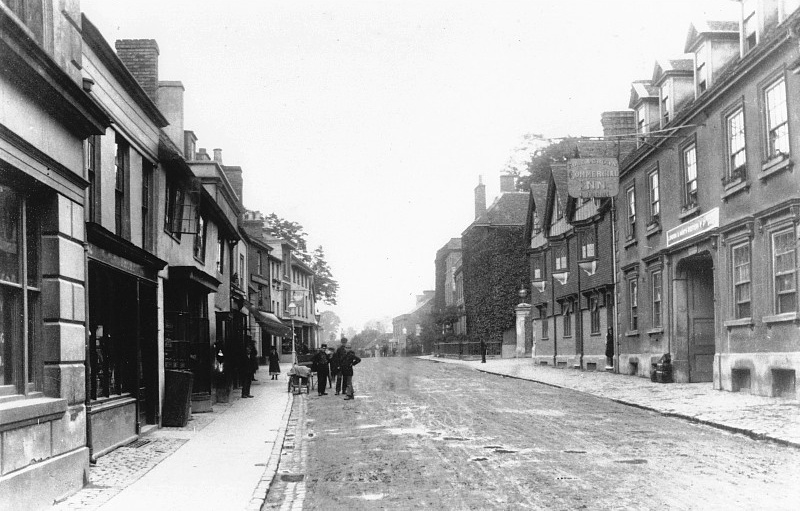
The Rose & Crown Inn
(immediate right) in the late Victorian era.
A large area of ground behind the hotel accommodated a bowling green
as well as providing a venue for fairs and circuses. An inn of
this type was considered a prestigious building and the central
focus of the town. During the next two centuries both members
of the Vestry and Excise Office made consistent use of the
facilities on offer, and an entry in the Vestry Minutes of 17
January 1711 records “William Gore Esq. [owner of Tring Park]
proposes that this Vestry be adjourned to the Rose & Crown to
consider and order all other parish affairs that shall be thought
needed”. In the 17th century the establishment was owned
by a well-known Tring family named Axtell who started to issue their
own trade tokens. [These tokens came into use because ‘the man
in the street’ had a problem - there was no official small change
for use in the market place, and innkeepers in particular were at a
disadvantage and many began to issue their own coins.] Those
from the Rose & Crown were stamped with “William Axtell. His Half
Penny” and the obverse side “1668 of Tring” and the sign
of the crowned Rose. Beer and porter were brewed on the
premises from the 17th century to about 1865, when the beer coolers
were removed to 15 Akeman Street. On William Axtell’s death an
inventory of his possessions disclose that he was a comparatively
wealthy man, the inn fully furnished on three floors; fully stocked
cellars and brewhouses; a woodhouse; a chaise barn and harness room;
and outbuildings for horses and cattle.
The 18th century saw the Golden Age of coaching and, Tring being on
a busy route to London, meant the fortunes of the Rose & Crown
increased accordingly. The Despatch, Sovereign,
and King William from Aylesbury, Leamington, and
Kidderminster called daily, and the inn’s own coach The Good
Intent ran to London three times a week. Such was the
increase in traffic that two other inns close by, the Plough and the
Bell, provided extra stabling. The advent of the railways must have
affected trade but, ever enterprising, the landlord in 1852 opened
‘the booking office of the London & North Western Railway’, and a
horse-drawn omnibus [see pictured below] carried passengers the
one-and-a-half miles to and from Tring Station.
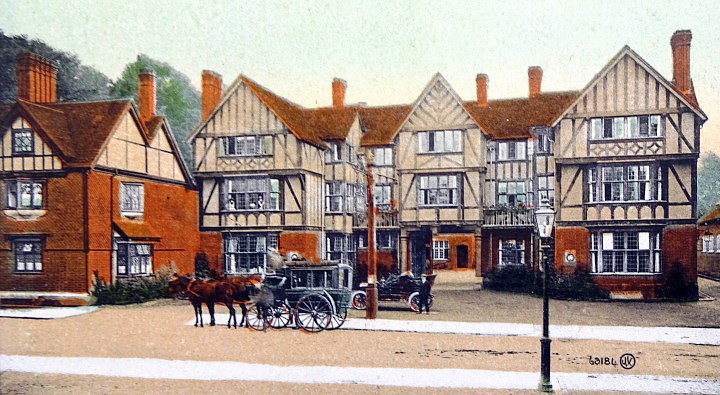
The new Rose & Crown Inn
by Tring architect William Huckvale.
The horse bus in the foreground ran a service to and from Tring
Station, 1½ miles distant.
In the Victorian age more prosperity came to Tring, and in 1904 the
townsfolk made an approach to Lord Rothschild, the Lord of the
Manor, with the suggestion that he should enhance the town with a
first-class hotel which they considered would benefit all. He
readily agreed, his action being reminiscent of the medieval habit
by which a landed lord erected additional accommodation to house the
influx of travellers whom by custom were his guests; the new hotel
had the added benefit of providing bedrooms for his personal
overflow of guests from Tring Park. When building work was
complete the finished hotel, with an imposing mock-Tudor facade well
set back from the road, was promptly handed over to the
Hertfordshire Public House Trust, an organisation promoted by the
Home Secretary, Lord Grey, to provide hotels with added sporting
facilities. And so the hotel has remained until the present
day when the need for such hotels in the centre of country towns has
almost disappeared, motorists preferring out-of-town travel lodges
with parking facilities and standard accommodation. At the
moment, we can only ‘Watch This Space’.
THE LATEST PLANS . . . . are indeed to abandon the hotel and convert
the building into apartments with, perhaps, retail outlets and
restaurants on the ground floor (Gazette 23 Nov 2011)
――――♦――――
HISTORY OF THE MEMORIAL GARDEN
by Time Amsden, January 2012.
|
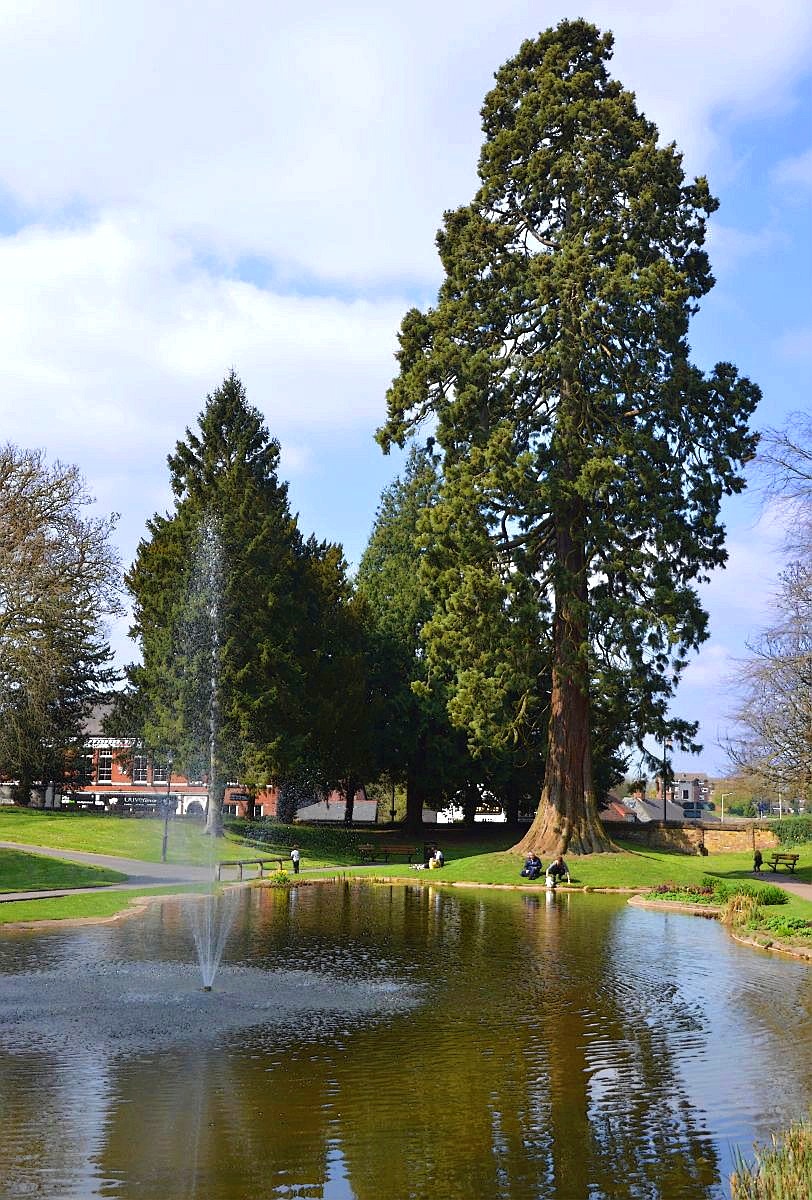 |
|
Tring
Memorial Garden |
The history of Tring is closely bound up
with that of the manorial estate of Tring Park, the origins of which
pre-date the Norman invasion of 1066. Much of the land around
the centre of the town belonged to it and some indeed still does.
For the last three centuries it has centred on the Mansion.
Well into the 19th century the hamlet of Lower Dunsley could be
found at the eastern end of the town, on the edge of Tring Park and
close to the Mansion. Its only street was effectively a
southerly continuation of Brook Street. In 1872 the Tring Park
Estate was bought by the Rothschild family. Nathaniel, first
Lord Rothschild, did not wish to have a village in such proximity
and in 1885 he had most of it demolished and its residents rehoused.
Liddington’s Manor Brewery and adjacent houses at the foot of the
High Street remained until 1896 when they too were demolished and a
wall was built to enclose the land. Further up the slope stood
the Green Man Inn, which lasted until the death of the landlord,
John Woodman, in 1903. It was then demolished and the wall was
continued so that the whole area was taken into the Mansion grounds
to create a water garden. A lake was formed as a lily pond and
trees including the huge Wellingtonia were planted.
The third Lord Rothschild put much of the Estate up for sale in 1938
although the Mansion and the park were retained. During the
Second World War the Mansion was used as offices of the family
banking business and subsequently became a school. The water
garden evidently became derelict during these years.
After the war, many people in Tring
including Councillor Robert Grace were keen to create something
permanent to act as a memorial to those who had lost their lives and
a thanksgiving for those who had survived the conflict. In 1947 a
questionnaire showed that a Garden of Remembrance was the most
popular suggestion and a committee was formed to raise funds.
It was agreed that the Mansion’s water garden was the ideal place
for such a purpose and by 1950 the land had been transferred into
the ownership of Tring Urban District Council. The ground was
cleared, the lake bed resurfaced and simple planting carried out.
An opening was made in the wall at the point where it met the 1711
wall across the Mansion vista. Gates were made by Bushell
Brothers’ boatyard at New Mill and the archway reading “Memorial
Garden” was made by Hampshire and Oakley of Chapel Street.
The Garden was unveiled in June 1953 to coincide with the Queen’s
coronation and dedicated by the vicar of Tring, the Reverend Lowdell.
In 1973 Tring Urban District was merged into the newly formed
Dacorum District and most of its properties, including the Memorial
Garden, were transferred to the new council. Simultaneously, Tring
Town Council was formed with specific responsibilities such as
allotments and other matters unique to the parish.
By the mid-1980s the Garden again presented a forlorn appearance.
People were reluctant to go there because the planting had become
dense and gloomy. A scheme for the improvement of Tring High
Street, drawn up by Derek Rogers Associates and promoted by Tring
Town Council in 1987, recommended that trees should be thinned and
the entrance reconsidered. Dacorum Borough Council agreed to
undertake this work and many trees, especially yews, were removed.
A length of wall was taken down, a new planting bed was created
alongside the High Street and the gateway repositioned, with new
gates made to replicate the old ones. The work was carried out
in 1989-90 with the restored Memorial Garden unveiled by the Mayor
of Dacorum in June 1990.
The same report observed that the self-seeded trees behind the
adjoining vista wall were overgrown and detracted from the setting
of the Mansion. The Arts Educational School removed the trees,
bringing the house back into view. The fourth Lord Rothschild
presented Tring Town Council with a strip of land in front of the
wall and this was then paved and bollarded, greatly enhancing the
appearance of this part of the town.
In 2001 the lake had to be drained and the fish evacuated when it
was found necessary to repair a crack in the concrete base. Members
of the Tring branch of the Royal British Legion attended a reopening
ceremony, and presented plaques listing the names of those men from
the town killed in World War II. These are mounted on the brick
gate-pillars at the entrance to the garden. Further work was carried
out to the lake in 2011, giving it a more natural appearance and
installing a fountain.
Tim Amsden,
with acknowledgments to Wendy Austin and Mike Bass
Note:
Dacorum Borough Council is hoping to achieve Green Flag status for
the Gardens, which will be officially ‘re-opened’ sometime in March.
The overall plan is to create more flower beds, enhance the area
with new trees, and remove some of the overgrown bushes and trees.
The Green Flag Award® scheme is the benchmark national standard for
parks and green spaces in the UK. It was first launched in
1996 to recognise and reward the best green spaces in the country.
――――♦――――
TRING’S RAILWAY SERVICE IN 1895
by John Savage, March 2012.
Today Tring station enjoys a more frequent train service (4 per hour
off-peak, and even 2 per hour for most of Sundays) than at any time
during its 174 year history, so it is interesting to compare this
with the service provided by the London & North Western Railway in
1895, as seen in Bradshaw’s Guide.
There were then 12 trains a day to Euston on weekdays (with 14 from
Euston of which one required a change at Watford) and 5 (3 from
Euston) on Sundays. Additionally there was a late night
facility from London on Tuesdays when the midnight train to Glasgow
stopped at Tring, to set down only, on informing the guard at
Willesden. Fascinatingly, this train made a different request
stop each night; Leighton (as the station was then called, being
renamed Leighton Buzzard on 1 July 1911) on Mondays, Tring on
Tuesdays, Boxmoor on Wednesdays, Berkhamsted on Thursdays, Bletchley
on Fridays and Kings Langley and Wolverton on Saturdays.
Another interesting addition to the service was the 5.00pm Euston to
Wolverhampton train, scheduled to run non-stop from Watford Junction
to Leighton, but which would stop at Tring to set down First Class
passengers only on notification to the guard at Willesden!
Business travel was quite well provided for with trains to London at
7.36am, 8.43am, 8.57am and 9.30am with a similar provision in the
evening. At other times the frequency was sparse with gaps of
over two hours between trains. Considering the relatively few
trains, rather bizarrely two of the trains to London ran within 5
minutes of each other (at 6.58pm and 7.03pm).
Compared to today where trains generally take 35 or 42 minutes (with
the fastest at 30 minutes) between Tring and Euston, the times in
1895 were considerably slower. Most trains took about an hour
and a quarter, with the slowest all-stations taking almost one and a
half hours. However, some of the trains at business times were
quicker, making the journey in just under an hour.
The trains serving Tring went to and from quite a diverse set of
places. On weekdays the trains to London originated from
Bletchley (x4) and one each from Liverpool, Stafford, Nuneaton,
Rugby, Northampton, Leighton, Cheddington and Tring. From
London the Tring trains went to Bletchley (x7), Tring (x2),
Cheddington (from Watford), Leighton, Northampton (x2) and
Wolverhampton. On Sundays the trains to London originated from
Bletchley (x2), Wolverhampton (x2) and Birmingham. From London
the meagre three trains went to Rugby (x2) and Leighton. I
should mention that this information is as best I can deduce because
in those days generally the timetable confusingly did not
differentiate between through and connecting services.
We will now look at the stations between Tring and Euston in 1895
and how they have changed since:
BERKHAMSTED (no change)
BOXMOOR (variously and erratically later Boxmoor & Hemel Hempstead,
Boxmoor for Hemel Hempstead, Hemel Hempstead & Boxmoor and
Hempstead; settling on Hemel Hempstead 1963/4)
KINGS LANGLEY (the intermediate Apsley was a late addition, opened
by the LMS on 26 September 1938)
WATFORD JUNCTION (no change)
BUSHEY (renamed Bushey & Oxhey 1 Dec. 1912 and back to Bushey 6 May
1974)
PINNER (renamed Pinner & Hatch End on 1 February 1897, Hatch End for
Pinner on 1 February 1920 and Hatch End on 11 June 1956. Now
only served by Euston- Watford local trains). The remains of
the old main line platform are still visible from the train.
HARROW (renamed Harrow & Wealdstone 1 May 1897)
SUDBURY & WEMBLEY (renamed Wembley for Sudbury 1 November 1910 and
Wembley Central 5 July 1948)
WILLESDEN JUNCTION (main line platforms closed 3 December 1962)
QUEENS PARK (no change)
KILBURN & MAIDA VALE (Closed 1 January 1917, reopened on same site
as Kilburn High Road 1 August 1923. Now only served by Euston-
Watford local trains)
LOUDOUN ROAD (Closed 1 January 1917). Later South Hampstead opened
at same location; remains of old station on main line still visible
from the train.
CHALK FARM (Closed 10 May 1915).
All of the then intermediate stations were served by some trains
to/from Tring, indeed some stopped at all of them! Willesden
Junction was then an important interchange with the radial North
London Line to Broad Street (for the City), Kensington, Clapham
Junction and through trains to the District Railway; almost all
trains, including long distance expresses, called there.
Fares in 1895 were: Tring-Euston (single) 5 shillings First Class
and 3s 4d Second Class. Third Class (known as “Parliamentary”
or “Gov” in the timetable because regulated by statute to 1d per
mile) was 2s 7½d,
exactly based on the 31½
miles (rounded down to the nearest half mile) distance. In the
reverse of today, in the early days of railways far more First Class
tickets were issued than any others, with Third Class trailing very
much behind. No doubt the poor and working classes neither had
the need nor means to travel.
In this time before bus services the railway would also have been
the means of travel from Tring to Aylesbury, by changing at
Cheddington (originally Aylesbury Junction) onto the branch line
(the world’s first branch line, incidentally) from there.
Indeed in earlier days there is evidence of through trains from
Tring to Aylesbury. The intermediate station on the branch
line at Marston Gate (on the Long Marston-Wingrave road) was usually
shown as a “signal” stop, i.e. by informing the guard if you wished
to get off or signalling the train to stop if you wished to board.
Finally, a lovely snippet from the timetable. The “Irish Boat
Express”, 9.30am Euston to Holyhead which ran non-stop from Watford
Junction to Northampton, conveyed a slip-coach, when required, for
Leighton during the Hunting Season. (A slip-coach was a
carriage attached to the end of a train, cast loose as the train
approached the due station, and brought to a halt by a guard with a
hand brake). To cater for such hunting parties to return from
Leighton the afternoon “Birmingham Express” would “stop by
signal at Leighton to take up Hunting Parties during the Season.”
――――♦――――
THE POLISH CAMP AT MARSWORTH
1948-1958
by Sandra Costello, July2013.
Polish servicemen and World War II
The heroic part played by Polish airmen, soldiers and sailors on the
side of the Allies during World War II is well known. However
from the early days of the War, Western Poland was occupied by
Germany and Eastern Poland by Russia. When peace returned to
Europe in 1945 all Poland was behind the Iron Curtain.
With the war over, most Polish servicemen did not want to return to
what they regarded as occupied Poland. One of the options
offered to them was assistance to start a new life with their
families in Britain. Many took advantage of this and as a
result some 30,000 Polish people came to live in Britain, where some
40 hostels were made available to house them in camps left empty by
the running down of British forces. Life was very difficult
for them: many had been forced for years to live in communal
conditions, and among them were many children who had never
experienced normal life. Those who came to Britain had to try
to assume again the responsibilities of independent people, but in a
strange land and with a different language.
The Polish Hostel at Marsworth
Some 900 Polish people, including whole families, came to Marsworth
in 1948, and were first accommodated in huts on the perimeter of
Cheddington Airfield at the end of Church Farm Lane. After
about five years the camp was relocated to a bigger and better site
once used by the RAF, then by the US Air Force, off Long Marston
Road. Food was cooked in central kitchens and eaten in
communal dining halls for the first two or three years, until
cooking stoves could be installed in the accommodation occupied by
each family. The huts did not have running water, and internal
partitions were few.
Affect on Marsworth
To begin with the village of Marsworth, with a population of only
316, objected to this huge influx. However according to a
report in the Bucks Advertiser of 1949, “Already the
people of Marsworth village have accepted them as ordinary families”
and the Polish people “now live happily in Marsworth”.
With the number of Poles exceeding the population of Marsworth by
nearly three times, the small local school did not have room for the
extra children. A school was therefore set up at the hostel
where virtually everyone, irrespective of age, attended classes to
learn English. One of the huts was converted to a chapel and
many community activities were carried on, including football,
volleyball, a youth club, women’s circle, and a Polish
ex-servicemen’s association.
The people of Marsworth were able to mix with the Polish community
by attending the dances, cinema and other entertainments held at the
hostel. This was a great help as the Poles were keen to learn
how British people lived.
The end of the camp
In the 1950s those at the hostel were eager for homes of their own
and a more normal life as part of the British community. In
their preparations for moving out of the hostel they learned a lot
from local people who helped them to gain confidence and make
contacts. Those who were able to work found jobs and this was
made easier when some employers provided transport in a variety of
vehicles from and to the Hostel. Contacts at work speeded up
the learning of English as well as improving knowledge of life
outside the Hostel.
The numbers living at the camp reduced steadily as families found
work and homes elsewhere, with the largest numbers leaving in the
first couple of years. In 1957 the Marsworth school roll
included the names of 25 Polish children, indicating that the school
at the hostel had closed. By the late 1950s numbers had
dwindled sufficiently for the few remaining to be accommodated
elsewhere, and the camp to be closed. The field that housed it
has since been returned to agriculture and all that remains is some
concrete. The only real legacy of the Polish presence in
Marsworth is some 15 graves in the churchyard of All Saints Church.
Those buried in the churchyard were mostly drowned — they swam in
the reservoirs, which were not allowed, but they could not read the
warning notices. Whenever there was a Polish funeral, all the
Poles from the camp turned out and the procession would stretch all
the way from the Camp to the Church.
For the Polish people, Marsworth was a pleasant village where they
were able to find security and become independent persons again, and
that gave assistance when it was needed after the horrors of war.
Polish return
In September 2008, Stanislaw Jakubas, now an Assistant Professor at
Krakow Academy of Fine Arts, paid a return visit to Marsworth.
He was born in 1948 at Bedford Hospital; his parents were then
living at the first of the two Polish camps — ‘Site Twelve’,
situated opposite Church Farm House. He recollected the
various ‘barracks’, but his memory was sketchy as he was very young.
He also remembered attending kindergarten at a building in Church
Farm Lane opposite the airfield (now long since returned to
pasture). He especially remembered playing with another young
boy, Ross Miller of Church Farm.
After about five years the Polish people were relocated to a bigger
and better camp situated near Bluebells, on a field bordered by a
concrete road leading towards Wilstone. He recollected the
layout of this camp, with its coal store at the entrance, the
various barrack buildings, the laundry and chapel. He attended
Marsworth School, and also remembered a large building then situated
opposite Lower End garage where concerts, etc. had been held on a
stage.
In 1956 Stanislaw went with his family to live in Canada. He
didn’t want to lose touch with his friend Ross, so he sent him a
letter in a bottle which he threw overboard. The bottle was
picked up 10 months later on the Irish coast. Apparently this
story made the BBC News and was reported widely in the local press.
‘Site 12’ was down a long lane close to the airfield and near a
yellowish brick farmhouse with several barns. The main site
was close to a canal. If you go to HP23 4NF on Google Earth
you should be able to see the latter site from the air. There
is nothing there now as all the buildings have been cleared for
farming.
――――♦――――
ANOTHER 100th ANNIVERSARY (not WW1)
by John Savage
1st March marked the 100th anniversary of Tring’s first motor bus
service on which date in 1914 the London & North Western Railway
took over the station route.
The station bus service, the earliest in Tring, started when the
station opened in 1837. It was to be over 80 years before any
other buses served the town. The horse buses were operated by
local people and by 1899 we know that the service was terminating in
the back streets at the “King’s Arms” probably where the
horses were kept. Change came in 1903 when the Tring Omnibus
Company was formed to take over the service; all the directors and
shareholders were local people. A new omnibus was purchased
for £99.15s and £300 compensation paid to the previous operator, C &
J M Buckle. Lord Rothschild soon joined the board, suggesting
that his financial support was already necessary. By 1906 the
company was in financial difficulties, and in 1907 resolved to go
into voluntary liquidation.
An unlikely rescuer came in the form of the Home Counties Public
Trust House (a forerunner of Trust House and Trust House Forte) who
owned “The Rose & Crown” and who took over the service,
terminating at the “Britannia” PH. In 1911 they
proposed extending the service to the Cemetery Gates in Aylesbury
Road, but it is not clear whether this actually happened; certainly
in 1913 it was curtailed at the “Rose & Crown” from the “Britannia”.
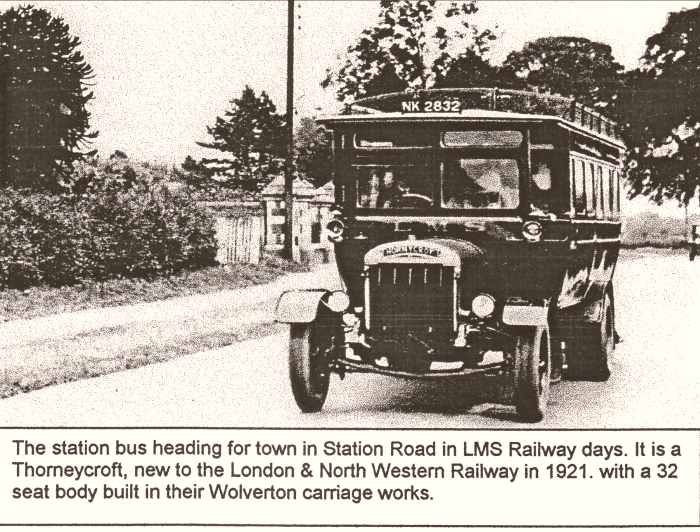
In 1914 the HCPHT gave notice that they were discontinuing the
service as they too had been unable to make it pay. Tring
Urban District Council requested that the London & North Western
Railway take on the service, which they duly did. The new
motor bus service terminated at the Cemetery Gates and provided a “frequent”
service between 8.00am and 9.30pm. With the grouping of the
railways in 1923 the service passed to the London Midland & Scottish
Railway which, in 1928, extended some journeys (on Fridays and
Saturdays) to Aldbury. By 1929 the service had again been
curtailed at the “Britannia”. Books of 24 or 50 tickets
could be bought from the station at a discount, and there were also
monthly season tickets.
With the imminent creation of the London Passenger Transport Board
the LMS sold out its local bus services to London General Country
Services in April 1933. LGCS changed the terminus to
Beaconsfield Road and gave it the route number 317. In July
1933 it thus passed to the LPTB (London Transport) who soon
renumbered it (by January 1934) to the familiar 387. Later in
1934 they gave the Tring Station to Aldbury section (still Fridays
and Saturdays only) a separate number, 387A, although this silliness
ceased in 1935 with all the service again becoming 387.
The more recent history is another story; other than to say that,
apart from an interregnum from 1985 to 2002 when the route was
numbered 27, it has stayed as the 387 to this day.
――――♦――――
THE TRING GAS LIGHT & COKE COMPANY
by Ian Petticrew, July 2016.
The development of gas lighting in the 19th century had a dramatic
impact on people’s domestic and working lives. Gas provided a
far more efficient and economic form of lighting than the candles
and oil lamps that preceded it.
In 1812, the London and Westminster Gas Light & Coke Company became
the first public gas manufacturing utility and it proceeded to
spread gas lighting through London’s poorly lit streets, an
innovation that soon became popular elsewhere. The first town
in our area to acquire a gasworks was Aylesbury. In 1834 the
Aylesbury Gas Company began operations on a site located at Hale
Leys. Gas became available at Hemel Hempstead in 1835 when a
gasworks was opened in Bury Road. In 1849, the Great
Berkhamsted Gas Light & Coke Co. was set up to provide street
lighting; and then . . . .
TO THE INHABITANTS OF TRING.
A public meeting will be held on Thursday evening next, March 14th
1850, at the Commercial Hall at 7 o’clock to take into consideration
the report of Mr. Atkins on the practicability of introducing Gas
into the Town.
The advertised meeting was well attended and ended with the
unanimous decision being taken “That in the opinion of this
meeting it is desirable that gas should be introduced into the Town
of Tring”. A committee was formed comprising William
Brown, Frederick Butcher, H. S. Rowbotham, Henry Faithfull and
Alexander Parkes to “ascertain the practicability of establishing
a Gas Company in this Town.” It was decided that the
prospective company would require capital of £2,000, to be raised in
£10 shares, and that each director would need to hold at least five
shares to qualify.
At this stage a site for the Gasworks had yet to be found, so the
directors took Atkins on a conducted tour of the Town during which a
former gravel pit on Brook Street was identified as a suitable
location. The gravel pit was the property of David Evans,
owner of the Silk Mill, who agreed to sell part of it to the Company
for £60.
Construction went ahead and gas was first released into the mains in
September 1850 . . .
On Wednesday last, the town of Tring was all in a bustle, in
consequence of that being the night which was fixed upon by Mr. T.
Atkins, of Oxford, the contractor, to light the gas for the first
time. Great preparations were made to celebrate the event, and
an immense concourse of people was present. The men who had
been employed at the works were sumptuously regaled with a supper,
at the Green Man Inn.
In gasworks of the time coal provided the raw material.
Wagonloads were delivered by rail to Tring Station and carted to the
gasworks by local hauliers. Gas was then extracted by baking
the coal in enclosed ovens called ‘retorts’ in which the coal was
starved of oxygen to prevent it burning. This process produced
a crude gas that contained unwanted substances, such as sulphur,
that had to be removed by purification before the gas could be
released into the mains. Other by-products were useful and
could be sold, including coke and coal tar - when motor vehicles
arrived and measures had to be taken to seal road surfaces to
prevent dust and mud being thrown up by this new faster-moving
traffic, coal tar mixed with granite chippings became a popular
road-surfacing material.
For over a century coal gas was manufactured at the Brook Street
gasworks on the site now being developed as a block of luxury flats
(old gasworks sites are generally heavily contaminated -
decontamination of the Tring site cost £400,000 before building
could begin). Many local businessmen served as the Company’s
directors until, in 1930, the Company was sold to outside interests.
In 1948 the Tring Gas Company (as it had become) was nationalised
and incorporated into the Southern Gas Board. Then, in April 1957
the following notice appeared in The Bucks Herald . . . .
Tring gas now comes from Oxford. For 105 years the 5,000 people
of Tring have had a gasworks, but Southern Gas now pipe from Oxford.
By then coal gas had a limited life. In 1967 the first natural
gas arrived from the North Sea and over the next 10 years British
Gas carried out a massive programme to convert gas appliances to
burn this new type of fuel. Tring converted to natural gas in
January 1969. For some years a large gasholder marked the site
of the Tring gasworks, but now all that remains is the former
gasworks manager’s house (by local architect William Huckvale).
GASLIGHT
COMES TO TRING.
――――♦――――
TRING ATTRACTS WEALTHY RESIDENTS
by Wendy Austin, September 2016.
Originally most men of influence in the City of London lived near
their workplace, but as they grew wealthier, they started to
consider more congenial surroundings for their families. The
age of commuting was born, mainly with a north-westerly trend, as
the lack of river bridges delayed development southwards. In
spite of the discomforts of coach travel at that time, these men of
substance began to buy country estates when a deer park was a highly
desirable status symbol. In 1702, Henry Guy’s property, the
Tring Park estate, became available and was purchased by Sir William
Gore.
Both figuratively and literally Sir William was very much a bigwig
in the City, for in 1692 he had been knighted at The Guildhall by
William III. In the same year that saw the arrival in Tring of
Sir William and his lady, he achieved the supreme appointment of
Lord Mayor of London and, to mark this event, the traditional
splendid procession and pageant had progressed through the streets
of the City. The gilded coach was proceeded by elaborate
horse-drawn floats carrying figures from mythology depicting finance
and enterprise. Among his business concerns Sir William
numbered a place on the committee of the East India Company, and was
a founder member of the Bank of England, his only setback being a
failed attempt to be elected as Tory candidate for the City of
London.
Daniel Defoe, passing through Tring on his travels, reported “at
Tring is a most delicious house, built å la moderne ” which
referred to the mansion purchased by Sir William. It had been
erected in the 1680s to a plain but pleasing design, said to be that
of Sir Christopher Wren. Surrounded by a small deer park, it
had gardens described as “of unusual form and beauty”.
Sir William’s healthy income soon allowed him to buy another 300
acres to add to his estate. He and Lady Gore, together with
their eight surviving children, presumably settled in happily and
started to enjoy the wide vistas of parkland, with a backdrop of the
beautiful beech woods along the Chiltern escarpment.
As we all know, even when one finds the ideal property, there is
always a snag — at the Tring Park mansion the problem was traffic.
The main road through the town at that time followed a route to the
south of the house, passing in front of the windows of the chief
reception rooms. The elegant walnut furniture and Delft china
probably rattled as coaches and wagons rumbled by and, an even worse
horror, the general populace could catch a glimpse of the family
dining. This state of affairs was swiftly rectified when Sir
William’s son inherited the estate, and petitioned to move and sink
the level of the road to the other side of the house. As this
then became the route of Tring High Street, today’s traffic
congestion in the town can be blamed firmly on William Gore junior.
He had not waited too long to gain his inheritance, for by 1707 both
parents were dead. Ever a dutiful son, he erected in Tring
Church an enormous memorial. Their life-sized marble effigies
are attired in the height of early-18th century finery, Sir William
wearing an immense and elaborate periwig. Accompanied by a
graceful gesture of his hand, he is discoursing to his wife, who
stares stonily ahead into space. Having now heard her
husband’s stories for almost 300 years, she is probably entitled to
look a trifle bored (below).
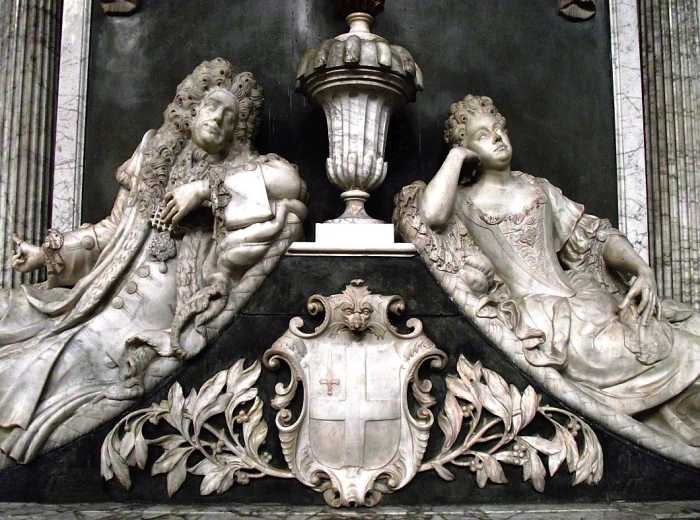
The Gore Memorial,
Tring Parish Church
In due course, Tring was also chosen for his retirement home by an
eminent banker. In 1931 Sir Gordon Nairne did not expect to
own anything so grand as a mansion in a park, for his origins were
modest, and his success in life had been built upon his own ability,
application, and integrity. He was a son of Scotland, born in
Castle Douglas and, after working in Glasgow, he entered the Bank of
England in 1880, and served there for fifty years until his
retirement. His talent for financial management was recognised
at the comparatively early age of 41 when he was appointed Chief
Cashier. Perhaps Gordon then allowed his grave features a
twitch of a smile of pride on the first occasion that he saw bank
notes bearing his own signature. The novelty must have worn
off, for he held the post for sixteen years, and part of this time
covered the critical period of the Great War. This was
especially difficult for banking as the Treasury issued currency
notes through the Bank of England in almost unlimited amounts, with
inevitable inflationary effects. The Bank was in safe hands
however, and Gordon Nairne received his deserved reward. In
1917 he was created a baronet, and the following year appointed to
the newly-created post of Comptroller. A Directorship followed
in 1925, Sir Gordon being the first member of staff to achieve this
position. His wise guidance was appreciated elsewhere too, as
he was honoured by other countries, including France, Belgium and
Japan.
When he left the Bank in 1931 he and Lady Nairne sought a pleasant
home in the country. Their choice fell on The Furlong, a large
house of unremarkable design in Park Road, built in the late
Victorian period by a wealthy vicar of Tring. The couple
entered into the life of the town, dutifully undertaking the worthy
sort of community activities that were expected from people in their
position. Sir Gordon remained a busy man, serving as a
Governor of the BBC, and as one of His Majesty’s Lieutenants for the
City of London; he also found time for his favourite pastime of
horse-riding. After a happy retirement he died in 1945 aged
84, and was buried in his family’s grave at Putney Vale cemetery.
Later, The Furlong became an annexe of a convent school, and was
then demolished in the 1980s to be rebuilt as retirement apartments.
For the time being, Tring’s ‘moneymen’ have departed. It
remains to be seen whether the twenty-first century will see yet
another eminent man of finance wishing to spend his annual bonus on
an expensive property and put down roots in our town.
――――♦――――
THE OTHER ALBERT HALL
by Wendy Austin, July 2018.
Forget the dominating and magnificent edifice on the south side of
Kensington Gore in London, as many and varied were the structures
erected to the memory of Albert, the Prince Consort. Some
people may not know that one such existed in Tring; unsurprisingly,
it can be found in Albert Street.
Its origins are obscure, but by the 1880s local newspaper accounts
show the hall served a useful purpose as a venue for various events
and meetings. For example, the Mothers’ Union gathered in the
hall; the Church Lads’ Brigade used it for band practice; William
Brown, the land agent and auctioneer, held sales there; technical
classes were run by Dr Spurway, who lectured on sanitation, nursing,
and first-aid, all of which were described as “useful to the
wives and daughters of working men”.
It also served as a useful space in which to hold bazaars and
rummage sales. At that time, the latter were obviously a
novelty, as one account shows it was necessary to explain to readers
exactly what a ‘rummage sale’ was. The account reads:
“ .... .. on Saturday 25th ult, the Albert Hall presented a
remarkable scene. At the invitation of the Vicar, the
parishioners had ‘rummaged out’ the contents of their attics,
storerooms, closets and dark corners and had collected what had been
cast aside as worn-out and useless, to be sent to the Hall, to be
sold for the benefit of the fund from which the little expenses of
the Parish Charities are defrayed. On the previous day, the
donkey cart of Cogger, the sexton, perambulated the town going from
house to house collecting the things that had been turned out for
the sale . . . . . . . .”
The Albert Hall also became the central point for the serving of
what were known as ‘Penny Dinners’. Organised by Tring
District Visiting, a national C. of E. charity organisation,
cardboard tickets (later metal discs) were distributed to the more
deserving children of the town by their school teachers, these
tokens to be exchanged for a nourishing meal. The food and
money was donated by well-off citizens of the town, the subscription
list being headed, of course, by Lord Rothschild. According to
the late Ron Kitchener, the meals were plain but sustaining, e.g.
pea soup, Irish stew and rice or jam pudding, he goes on to quote
that in the first year of the scheme, 1,307 tokens were issued.
By the end of the century many other general gathering places had
sprung up in Tring, and possibly the hall became under-used, as the
premises were then shared with Henry Stevens, a town councillor who
owned a shoe shop at No.15 High Street. He set up a small
factory in the Albert Hall which he called ‘The Shoe Mart’ and
advertised his wares for sale in The Tring Gazette; examples
of his boots and shoes were also exhibited with great pride at Tring
Agricultural Show and other such events. This operation was
closed down and sold in 1899.
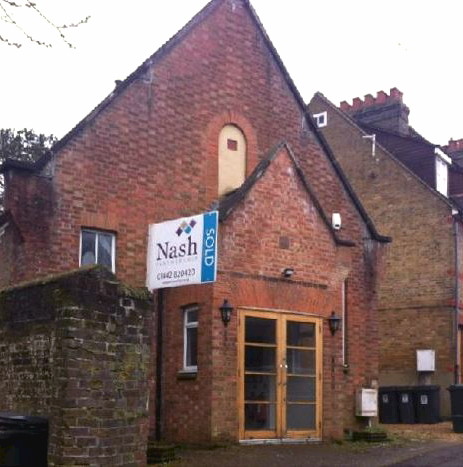
The former Salvation
Army hall in Albert Street,
February 2014
A year later the premises became a meeting place for members of
Tring Salvation Army who, up until then, had worshipped in what was
described as “a draughty uncomfortable little carpenter’s shop”;
the Albert Hall then became known as The Barracks. What
happened over the next 20 years is unclear, as an advertisement of
1924 states that the premises were owned by Messrs. Rodwell & Sons
who offered it for auction citing that it was ‘a good site for a
small factory or similar’, but even so it failed to attract a
purchaser. But a little later the premises were acquired by
the Salvation Army, and approval for erection of a new building, at
an estimated cost of £1,550, on the site of the Albert Hall was
granted in July 1926, with demolition a few months later. The
following year The War Cry was able to report on the opening
ceremony of the new Citadel:
“ .... .. for some years the comrades of Tring have laboured
under the disadvantage of having no permanent building in which to
hold their meetings. This came to an end last Saturday when,
amid scenes of enthusiasm mingled with praise and gratitude to God,
they entered their new Citadel .........”
There was good reason for ‘enthusiasm’ as the Tring branch of the
Salvation Army had waited 38 years before attaining its own meeting
place. Major modernisation of the premises were carried out in
2001, but the history of the Salvation Army in the town came to an
end in 2014 when the building then became an arts and education
centre. It now serves as Tring’s Yoga Studio.
――――♦――――
THE TRING AND AYLESBURY TRAMWAY
that might have been,
by Ian Petticrew, September 2018.
The street tramway arrived in Britain in 1860 when American
entrepreneur George Train opened a short line at Birkenhead.
It was not long before most of Britain’s cities and towns of any
size had trams.
Motive power was at first provided by horses, but in an age of steam
attempts were soon made to use it to replace animals. The
small steam ‘tram engines’ that resulted were expensive to run and
maintain, so when more compact and efficient electric traction
became feasible in the 1890s it quickly replaced steam.
However, one steam tramway survived longer than others. The 2½-mile
Wolverton and Stony Stratford Tramway opened in 1887 to bring
workers from outlying districts into the London & North Western
Railway’s large carriage works at Wolverton. It ran until 1926
earning the dual distinctions of having the largest trailer cars in
Britain (seating 100 passengers) and being our last steam-worked
street tramway.
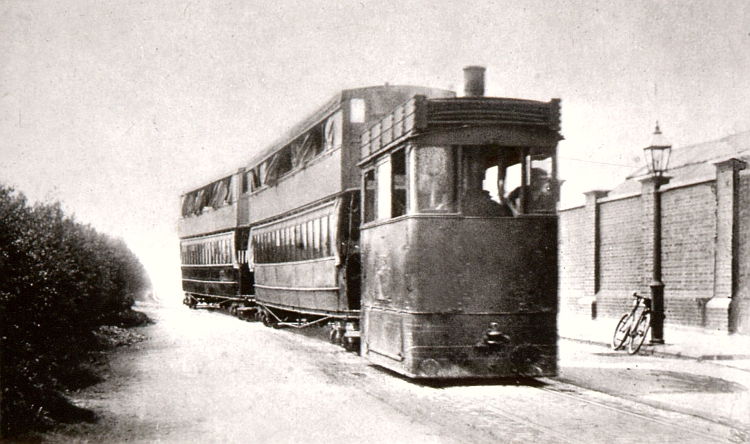
The Wolverton steam
tramway
In 1887, reports appeared in the local press of a plan to build a
tramway linking Tring Station, via the town, with Aylesbury —
whether the system was to be steam or horse powered is not
mentioned, but taking account of the length of the line and its
gradients, steam seems likely. At the same time a grander
scheme was announced for a steam tramway linking Hemel Hempstead,
Boxmoor, Chesham, Berkhamstead and Northchurch. Descriptions
of the route and its gradients held in the Hertfordshire Archives
show that detailed surveying was carried out before the scheme was
announced. The line was to commence opposite the goods
entrance to Tring Station, cross the Grand Junction Canal over the
existing bridge and proceed up Station Road (gradient 1:65) to Tring
Lodge, after which it would descend (1:20) to Brook Street.
The line would climb steeply at Frogmore Street (1:18) followed by a
gradual ascent to the summit of Tring Hill (1:48) before descending
(l :20) to the Vale of Aylesbury, after which the route to the
Aylesbury terminus was comparatively level (1:100).
Press reports do not mention the extent to which the scheme was
supported by the townsfolk, but there were some objectors:
THE TRAMWAY SCHEME. — A Tring correspondent writes: We understand
that Lord Rothschild, Mr. Williams, and other owners of property in
the narrow part of the High-street have objected on public grounds
to the laying of the Tramway there. Even with the present traffic
the street is narrow and insufficient, and accidents, especially on
market days, are not infrequent. The promoters will, it is thought,
abandon the scheme, without incurring the expense which opposition
at a later stage of the order would entail upon them.
Bucks Herald, 17th
November 1887.
When the Tring Local Board met to discuss the scheme, their main
concern was that part of the High Street was too narrow to meet
statutory requirements:
LOCAL BOARD.— The Clerk read several sections of the Tramways’
Act, 1870, which referred to the position of the Board with regard
to the persons interested in that portion of the High-street which
was too narrow to allow the required width on each side of the
rails.— Mr. Elliman thought they should not forget that the tramways
would give facilities for getting about, and that they were
generally advantageous to a town. It might be the wish of the
townspeople to have the tramway.— After some discussion, the Clerk
was directed to issue a circular, drawing the attention of the
inhabitants to section 9 of the Act of 1870, which provides for the
case in which the street is too narrow to admit a width of “9 feet 6
inches between the outside of the footpath on either side of the
roadway and the nearest rail of the tramway.”
Bucks Herald, 3rd December
1887.
The Tring and Aylesbury Tramway scheme was finally laid to rest when
its promoters met Lord Rothschild, whose main objection to the
tramway was that it would not be a financial success. How this
would affect anyone other than the scheme’s promoters and
shareholders is unclear, for they would probably have been required
to arrange a bond to cover the cost of road clearance should the
scheme fail. The following newspaper report also refers to
other objections, which presumably included the narrowness of the
High Street, while local folklore has it that his Lordship objected
to trams passing his residence:
THE PROPOSED TRAMWAYS SCHEME.— It is stated that Mr. Wilkinson,
the promoter of these schemes, accompanied by the solicitor and the
engineer, had an interview with Lord Rothschild, Messrs. Leopold and
Alfred de Rothschild being also present, at New Court, St. Swithin’s-lane,
on , Wednesday, as to the proposed line from Tring to Aylesbury, and
that his Lordship having intimated that the line would not receive
his support because, among other objections to the scheme, he
considered it was a line which would not be a financial success, it
was decided to abandon the project. But as his Lordship at the
same time intimated that he felt certain that the line from Chesham
to Hempstead would be supplying a long-felt want to the district,
and also prove a certain commercial success, it has been decided to
press forward the project with the upmost vigour.
Bucks Herald, 24th
December 1887.
What is surprising is that the tramway promoters appear not to have
foreseen such predictable obstacles before incurring surveying,
planning and legal expenses. To modern eyes it might also seem
extraordinary that his Lordship’s word should carry such weight in
the matter, but this was an age in which the peerage was
considerably more influential than today, as is evidenced by the
London & Birmingham Railway’s application to Parliament in 1832,
which was thrown out — at great cost to the Company — by Lord
Brownlow of Ashridge and a coterie of peers who had no more
justification than they happened not to like railways.
As for the Hemel steam tramway scheme, it too sank without trace.
Newspaper reports suggest that although it met with public approval,
there were also influential objectors among who was Sir Astley
Paston-Cooper, a landowner in the Hemel area (whose ancestor’s
objections had helped cause the route of London & Birmingham Railway
to be changed). Cooper, it appears, “thought the tramway
horrid. People in London liked to come into the country to
enjoy the peace and quiet there, but would they come if a beastly
tramway were introduced?” The Hemel scheme did obtain its
Act of Parliament, but despite overcoming that legal obstacle to its
construction it was abandoned, probably owing to lack of finance.
――――♦――――
A WALK AROUND TRING
as it was in the eighteen nineties
by Joseph Budd (written
c.1966)
In these days of Progress and Changes and with the town centre the
subject of much debate, suggestion and criticism, it might be
interesting to walk round the town and recall some of the features
which have changed during the past three quarters of a century.
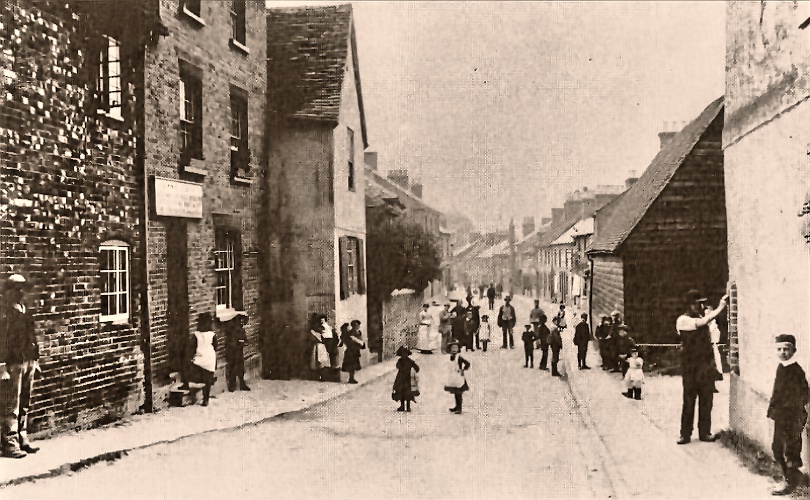
View looking down Akeman Street.
The Jolly Sportsman (now Louisa Cottages) is on the left.
Photo courtesy of Jill Fowler and
Mike Bass.
About 1890, the extent of the town would have been described as
“from Lower Dunsley to Bottle Cross, and from the Red Lion to the
Jolly Sportsman”. This does not convey much information today, but
we will indicate these cardinal points as we walk round.
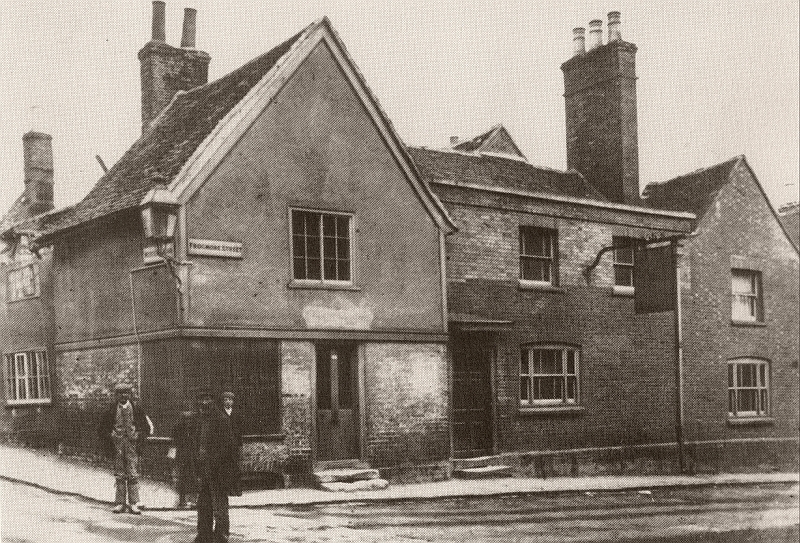
The George public house at the
junction of Frogmore Street and the High Street.
Photo courtesy of Jill Fowler and
Mike Bass.
Where to start? Where else but the “George Corner”, but a different
prospect from the present time, with the original George Hotel some
yards further east making the entrance to Frogmore Street narrower
than it is now.
|
.JPG) |
|
Joseph in Home Guard uniform, 1943 |
A shop on the other corner of Frogmore Street was Mr Dan Bedford’s
barber’s shop, haircut two-pence, shave one penny. Opposite to this
on the corner of Akeman Street was Mr Jeffrey’s chemist shop, still
a chemist but the name Jeffery is vanished many years ago. The two
great flasks of coloured water have also gone, replaced by one only
half the size. Two fishtail gas burners behind them showed them up
splendidly well as illuminating the shop. Another small burner on
the counter was used for sealing wax. When dispensing a bottle of
medicine, Mr Jeffery always wrapped it in paper and sealed it before
handing it over.
On the other corner of Akeman Street, on the site of the present
Market House, was Mr Mead’s slaughter house. This also was further
east making Akeman Street as narrow as Frogmore Street. The
slaughter house was a timber building, heavily tarred, with a hole
in the boards low down through which a rope could be passed to pull
down a bullock for the poleaxe. Boys on their way to school would
often help to pull.
We will now leave the crossroads and explore the High Street. Next
door to the chemist was Mr Lawsons grocery store, a good shop well
stocked. One department was the off licence, and one line here that
sticks in the memory is a quart bottle of Tarragona Port for two
shillings. The liquor trade has now ousted the grocery trade but
next door Mr Brown’s brewery has reversed the process and “gone dry”
being now a butcher’s shop.
Doctor Brown’s surgery was next door, and he had not yet built Harvieston in Aylesbury Road, now the Convent of St Francis de
Sales.
Next, Mr John Bly’s furniture shop and Johnson’s butcher’s shop and
slaughter house, the site now occupied by the Midland Bank [on
the right
of the picture below].
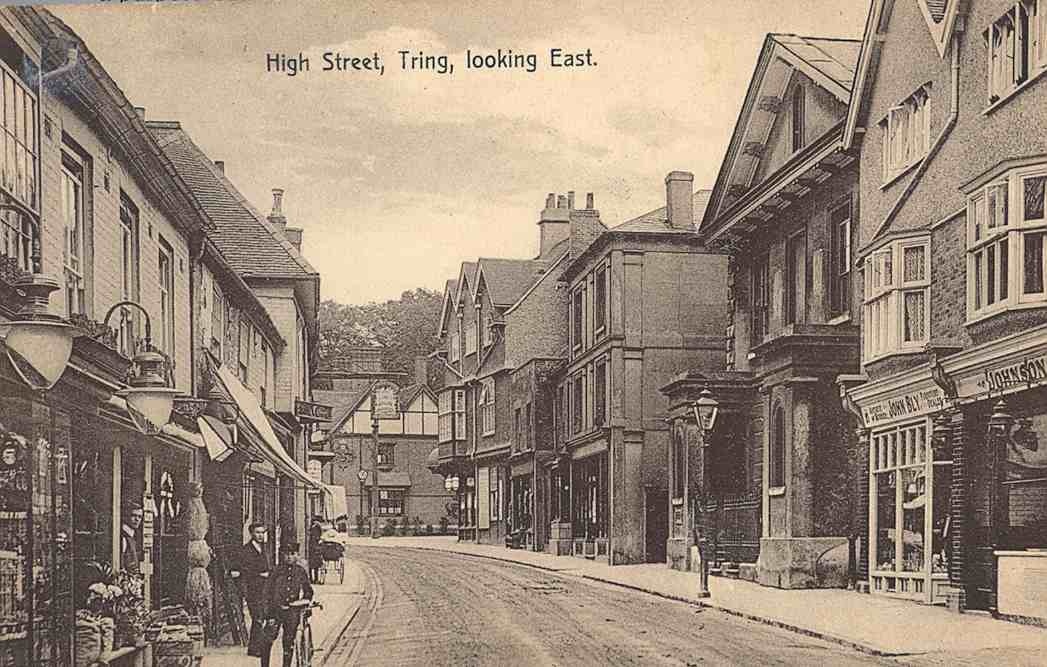
Bank Alley was much the same as at present, except that there were
cottages on the right hand side going up. They were dilapidated
smelly old places, but some were still occupied. One of the last
tenants was old Mr Rivett, a little old man who had to use two
sticks to walk. He was one of the people who had to exist on Parish
Relief, a few shillings to prevent absolute starvation. An
occasional shilling from people like Mr Tommy Glover was a godsend
to him. His end was rather pathetic. His favourite walk was to
Thorn’s Meadow in Station Road, to sit on the grass. One warm
afternoon he just sat and died. He had a Pauper’s Funeral in the Old
Cemetery, not very elaborate.
The bank adjoining the Alley was at that time Butcher’s Bank, but
has changed its name and proprietors several times, ending up as the
National Provincial.
Glover’s next door was considered the premier grocer’s in the town,
carrying a large stock of provisions, and also in their off-licence
department being agents for W & A Gilbey’s wines and spirits.
Incidentally, they supplied a good part of the groceries to
Rothschilds at the Mansion, and when Mr Tommy Glover called there
for their order (which he always collected himself), it was
customary for his to be taken through to Lord Rothschild for half an
hour of friendly conversation.
Several shops followed before the Rose & Crown, including Baldwin’s
(tailor), Stevens (boots and shoes), Allison (corn chandler), etc.
The Rose & Crown, which stood flush to the footpath, had been the
principal coaching and posting house, but of course those days were
over, and though the stables still contained plenty of horses, the
vehicles were no longer coaches, but Broughams, Landaus, and even a
wagonette. Mr Jesse Thorn was the landlord. He rented the first
meadow on the left in Station Road for his horses in the summer, and
it was known as “Thorn’s Meadow” right up to the time houses were
built on it a few years ago.
Passing the entrance to the Avenue, we shall come to Mr Ebenezer
Charles Bird’s stationer shop and printing works. This shop was up
some steps, but the stocks of pencils, crayons, writing books, etc.
were a magnet to small boys and girls with a few coppers to spend.
Mrs Bird was a nice woman and very kind to juvenile customers. This
was Mr Bird’s second wife, his first having died in 1849 at the
early age of twenty-five. Her tombstone in the churchyard bears the
touching inscription; “Life is even as a vapour which appeareth for
a little while, and vanisheth quickly away.”
This was the last shop before the Market Place. On Fridays the first
stall this side was invariably that of Mr Garner, pastry-cook and
cake baker, from Aylesbury. One of his best known lines was a
Madeira cake, complete with paper band and a liberal piece of candy
peel on the top, for one penny. Looking over the wall on this side
of the Market Place we should probably see an emu or a kangaroo or
two surveying the scene from their elevated position, and quite
unperturbed by the passing traffic. The road being below the land on
either side, in what was known as a “Ha-ha”, was not visible from
the Mansion, and the vista from there appeared to be unbroken grass
all the way to the horizon.
At the lower end of the Market, where the Memorial Garden Gates now
stand, was the Green Man public house. The landlord was Mr Woodman.
He collected the tolls from the stallholders, and as he approached
each one he had a habit of rattling the shillings he had already
taken, and naturally became known as “Jinker” Woodman.
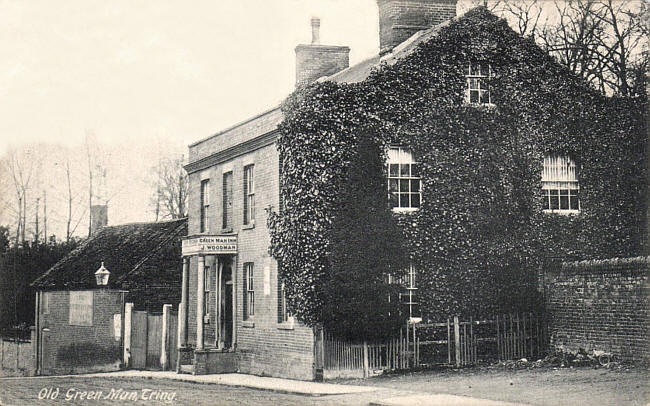
The Green Man public house
Beyond the public house was Doctor Pope’s residence. This was a
rather nice house, complete with stables and coach house. He kept a
smart carriage and employed a coachman. When this house was
demolished it was interesting to note that the window frames were
made of mahogany; quite unusual.
From here to the beginning of London Road was Lower Dunsley, so
called from its proximity to the “Dunsley Field”, the ancient name
for the field which is now Dunsley Farm, and to distinguish it from
Upper Dunsley, a collection of old cottages standing near the site
of the present farmhouse and buildings. Near the turning to Upper
Dunsley, near the main road was the “Pound”. This was a fenced
enclosure in which any horse or farm animal which strayed upon the
highway could be confined until redeemed by payment of a fine to the
Overseers of the parish. The meadow is still known as Pound Meadow.
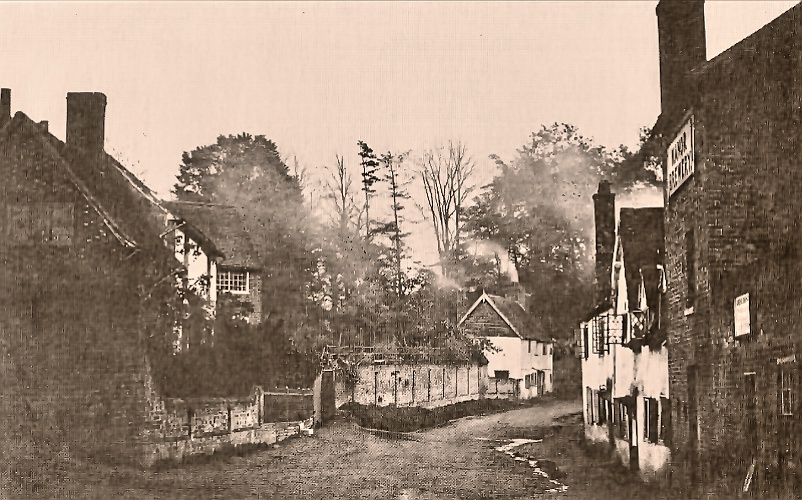
Lower Dunsley viewed from the
Robin Hood Corner.
Photo courtesy of Jill Fowler and
Mike Bass.
To return to Lower Dunsley, the iron marker of the Sparrows Herne
Trust can still be seen. These were the people who maintained the
road and took tolls at the various turnpike gates on the London
Road.
Near the marker stood the “Hole in the Wall”, an old-fashioned
public house complete with oak-beamed tap room, and a copper
“Muller“ for anyone who wished to warm their beer. This did
occasionally happen on very cold days, but most beer drinkers would
say “It’s poor beer if it won’t warm itself”. The name was only a
nickname, as it was only a beer-house retailing beer from the
adjacent brewery.
Standing in front of the Hole in the Wall, and looking down Brook
Street, one would have seen, on the present Cattle Market, a row of
cottages. These belonged to the Silk Mill, and had been in
bygone days occupied by “Prentice Girl”. These were
girls who had been an expense to the Overseers of their home
parishes, and if a girl had a good character she could be accepted
as an apprentice at the Silk Mill and earn her living. There
were “house-mothers” in charge of these girls, several of whom
eventually married Tring men.
The Mill Pond at this time filled all the space from here to the
Silk Mill itself, but when the waterwheel was no longer used most of
it was filled in and planted with fruit trees. These trees
have now about finished their useful life, and in 1966 no one
bothered to gather the crop.
Leaving the prospect of Brook Street and returning to the Market
Place, and passing Mr Billy Fulks’s butcher’s shop, we should find
the Green Man meadow, which was the recognised site for visiting
circuses. One that came every year was Fossett’s, a good
little show, but when “Lord” George Sanger’s circus came, that
really was an event. The procession around the Town was indeed
something to remember. The great wagons drawn by teams of six,
eight, nine or even twelve horses had to be seen to be believed.
There being no overhead wires such as telephones and electricity
supply, the wagons could be built up to a great height and the
climax of the procession would probably be Britannia or some other
allegorical figure, seated on a throne nearly twenty feet above the
roadway.
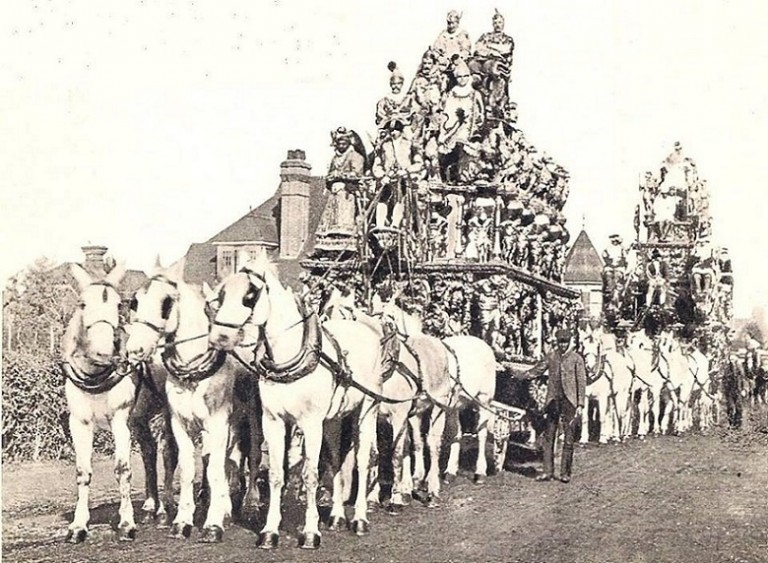
A Sanger’s circus parade.
Leaving the Market Place we should pass Mr Putman’s grocer’s shop,
and Tomkins ironmonger’s ditto, and come to the Plough Inn,
landlord Mr John Penn (now Frank Bly’s shop). Several of the
plait buyers from Dunstable and Luton used to make The Plough their
headquarters on market day.
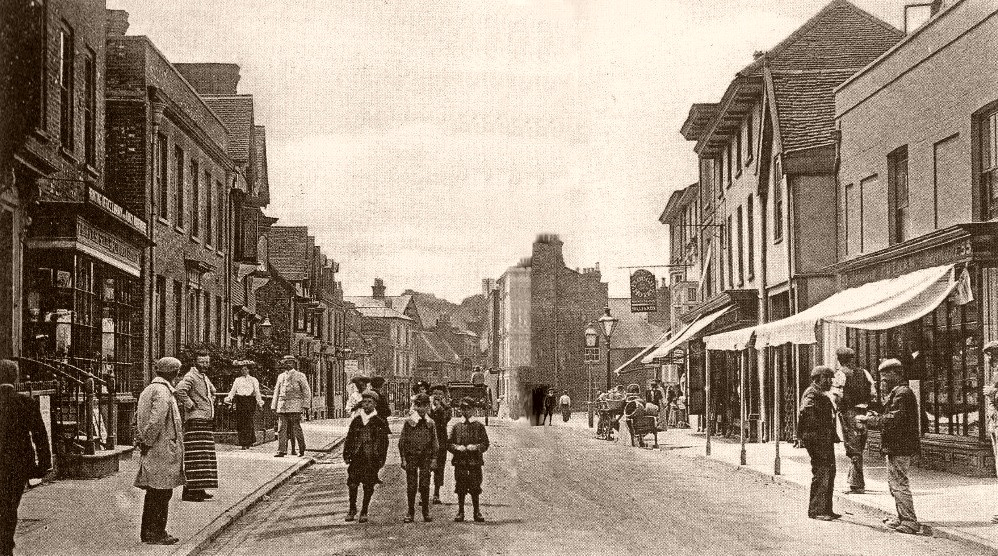
The High Street looking West -
the old Market House (below) has been demolished
Following on, to what is now known as Church Square, with its car
park and bus shelter, here stood the old Market House. This
was an ugly old building of two storeys, the ground floor paved with
flag stones and enclosed by very heavy iron fencing, and the upper
story entered by a door in the eastern end by means of a removable
step ladder. On the ground floor, in a brick wall, was the
entrance to the “cage”. This was a dungeon-like cell, very
strongly built, dark, and with an oak door four or five inches
thick. There was a stone bench for the occupant to sit on, and
the whole place looked most cheerless and uncomfortable. There
was a small grille in the door for observation purposes.
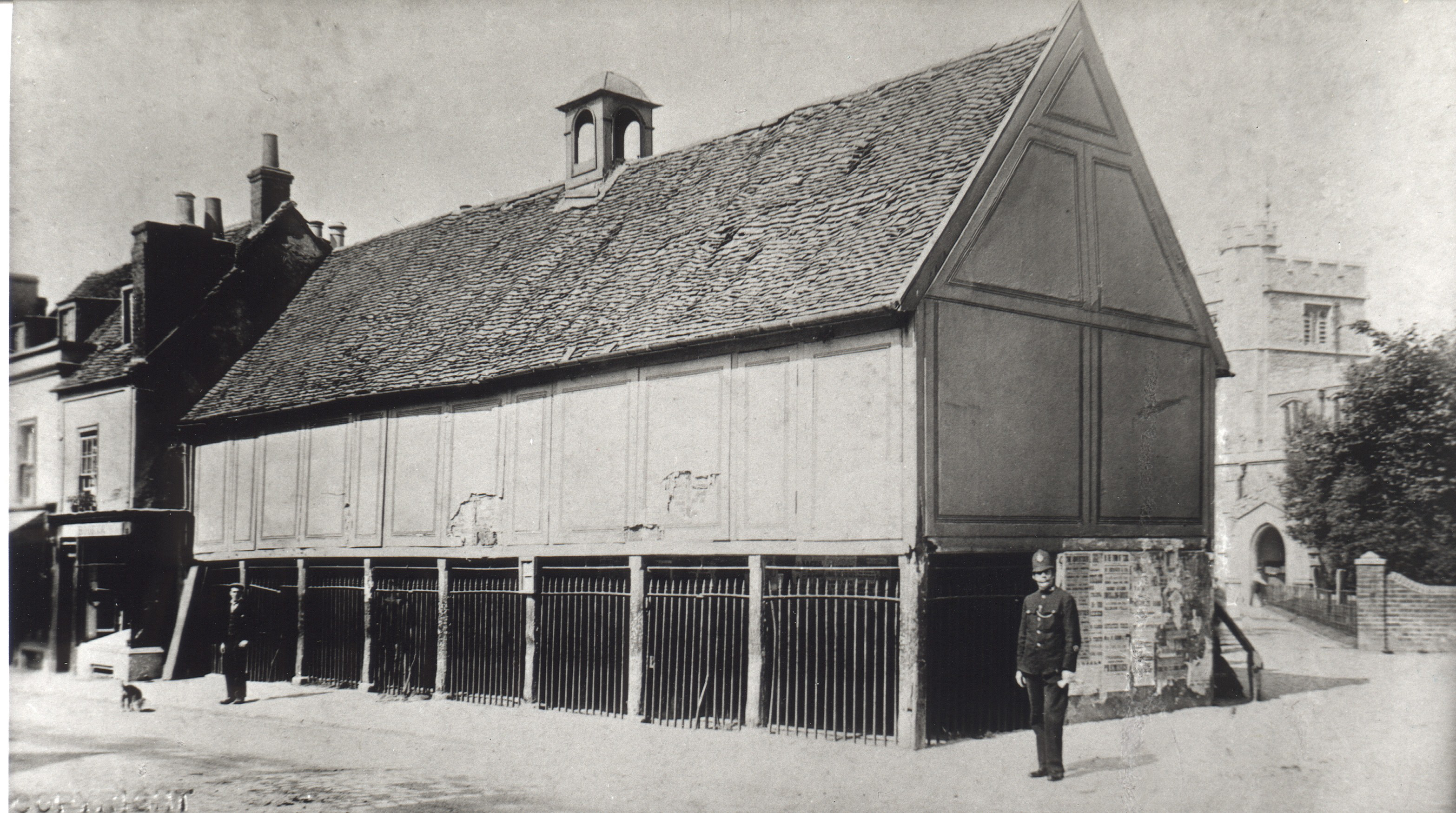
The old Market House in what is
now Church Square.
If the old building were to be standing today it would be venerated
as an ancient monument, but at that time it was only on eyesore,
especially to Lord Rothschild when he came out the of the Avenue in
his carriage, and when his Lordship gave a site for a new Market
House at the corner of Akeman Street it was gratefully accepted and
the old one demolished.
Next to the Market House was Mr Booker’s fish shop and the last shop
before what is now Brown & Merry’s offices was Thorps (another
grocer). A memory of this shop is of whole cheeses stacked
five high on either side of the doorway.
The Bell Inn was one of the pubs that opened at 6 a.m. for the
benefit of customers who had drunk a “skinfull” overnight, and
needed a “livener” to “waken the dead”.
Among the shops on this side of the street were Mr Clement’s
(jewellery, watches, etc.), Pitkins (saddler and harness maker),
Greenings (drapers and clothiers), and Mr James Edwin. This
last shop was famous for pork pies, which were known for many miles
around.
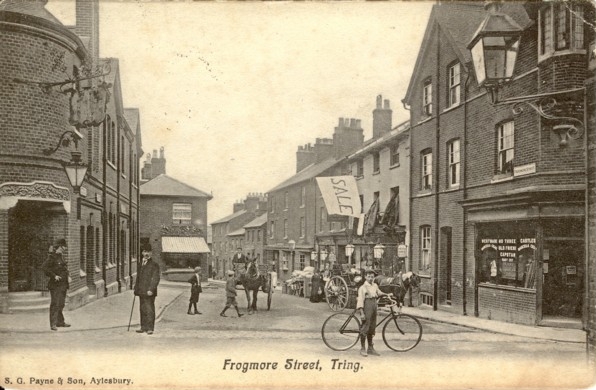
Above: looking down Frogmore Street from the crossroad
Below: looking up Frogmore Street towards the crossroad
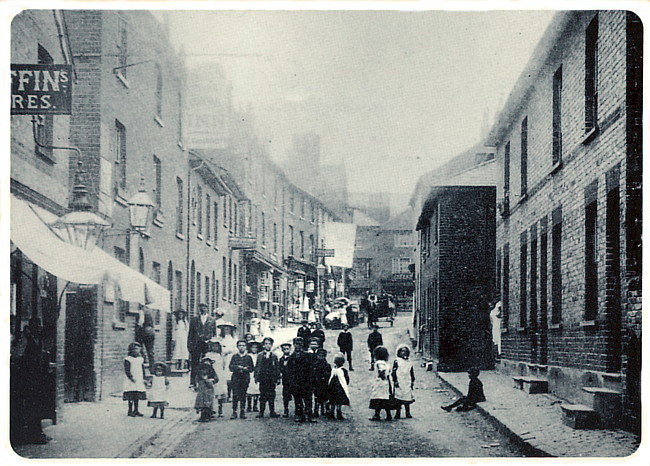
We are now back to Frogmore Street. Passing Parsonage Lane,
Church Lane, Stratton Place, and Westward Lane, we should come to
the “Square”. This is what is now the Car Park, and consisted
of a row of cottages in front, with an archway giving access to a
yard behind surrounded by other cottages, with no back doors.
When they were demolished some of the resident families were moved
to “Sugars Green”, the council houses off Brook Street near the Gas
Works. A few yards beyond the Square was the Pawnshop, which had a
regular clientele among the poorest and most shiftless of the
populace. Next to the pawnshop was the Fellmonger’s Yard, no
longer used as such but keeping the name. A fellmonger dealt
in sheepskins, which he processed in such a way as to remove the
wool and leave the skins ready for conversion into thin leather,
suitable for making such things as hedging gloves, etc. The
process was eventually concentrated at Thame, and then the skins
were only collected here, and taken there by Mr Jack Olliffe with
horse and van.
Almost opposite to the Fellmonger’s Yard was the “horse pond”, the
last remaining evidence of a stream which at one time ran through
this valley to the Brook (of Brook Street), crossing the road in a
watersplash. When the Silk Mill was built, and the Mill Pond
made, this was the main source of the water supply for the
waterwheel which drove the machinery. A culvert was put in
crossing Pond Close and discharging straight into the Mill Pond.
Next to the Fellmonger’s Yard was the Black Horse pub, and next
again the Red Lion. These were both lodging houses as well as
beer houses. They catered for “travellers”, not tramps, but
such people as organ grinders, street singers, German Bands, mat
menders, dancing bear keepers, fire eaters, knife grinders, etc.
The Red Lion had an annex in the back yard which served as kitchen
and day room for the lodgers. The scene in there when a dozen
or more were present would have made a good picture for Hogarth.
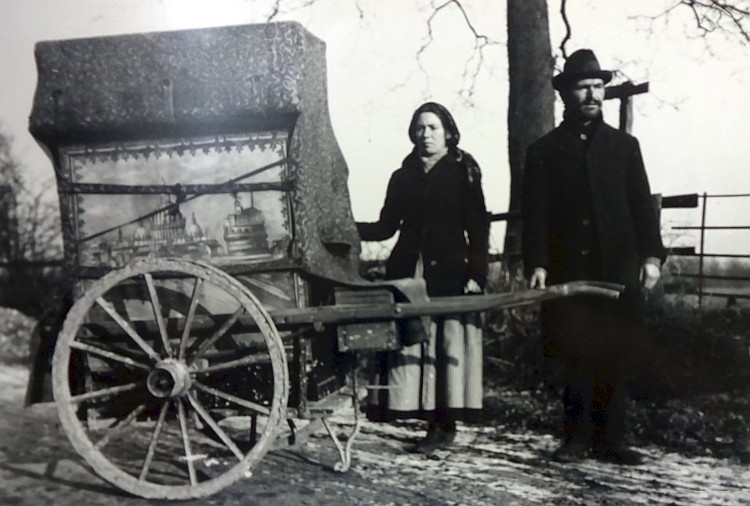
This couple would visit Tring
every 6 months and stay in the Red Lion
for 1d a night, leaving their barrel organ parked in the yard.
Behind this, on land now partly covered by the telephone exchange,
was Saws Alley, a row of old cottages built in such a way that the
earth at the back was almost up to the upstairs windows. Mrs
Saw lived in one, and the remainder were occupied by a poor class of
tenants. When Mrs Saw died, and her house was cleared out,
there was more than half a ton of old clothes, garments which
tenants had persuaded her to accept in lieu of rent.
Back in Frogmore Street, and almost opposite to the Square, was the
Chapel, built in 1751 (and still used as such in 1890). Like
other Baptist chapels in the Town, this one has a gallery to
accommodate the expected large congregation, but whether it was ever
necessary is a moot point. The people who built it never
imagined that it would end its days as a residence and antique shop.
Arriving back at the High Street and proceeding up the School Hill,
one of the first shops to catch the eye was a harness maker’s.
This was kept by Mr Jennings, universally known as “Dad” Jennings.
He was also the bandmaster and conductor of the Town Band. A
few yards up the hill on the other side of the road is the
Conservative Club. When this was being built some ill feeling
cropped up between two bricklayers working on the front gable end,
and the two hob carriers serving them with bricks. It was a
tidy height and the labourers were inclined to take an occasional
rest, at which the “brickies” would ring their trowels and call for
bricks. In retaliation, the two hod carriers decided to
overwhelm them with bricks, and in a little while they had more than
a ton supported by one “ledger”. Of course it broke, and down
came scaffold planks, putlogs, bricks, hods and carriers. It was a
marvel that no one was killed.
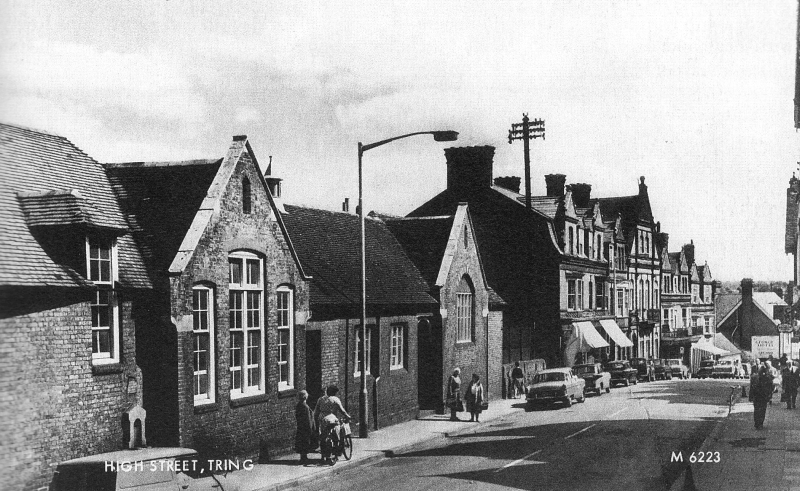
Tring Junior School, formerly
Tring National School.
Photo courtesy of Jill Fowler and
Mike Bass.
A few yards further at the top of the hill were the National
Schools. About this time great excitement was caused one day
by a stag which ran through the High Street followed by Lord
Rothschild’s stag hounds. It was cornered in the boys’
playground. Fortunately the whippers-in were well up and were
able to net the stag and keep the hounds off until the stag cart
arrived, when he was loaded up and taken back to Ashridge Park
whence he had been borrowed.
The schoolmaster was Mr Henry Hobson, and although his eyesight was
failing he was long remembered for doing wonders with the boys he
had, in the time he had them. They would leave school at any
time after their thirteenth birthday and if a boy had not got a good
grounding in the threes “Rs” by then, it was most likely his own
fault. If a boy had reached Standard Four he could take what
was called the “Labour Exam”, and if he passed he became a
“half-timer” when he was twelve. After this, for the next
year, he only attended school five half-days a week, and could go to
work for the rest of the time.
The other end of the building was occupied by the girls’ school.
The school mistress was Miss Luffman, and like Mr Hobson she held
the post for a long time. She is still spoken of with respect
and affection by some of her former pupils.
Opposite to the boys’ school was the chemist shop of Mr Marsh, where
many a boy had an aching tooth extracted for which the charge was
one shilling without anaesthetic.
the High Street Chapel was nearly new, having been built in 1889,
which from the start had attracted a numerous congregation. It
was not as strictly sectarian as some and eventually became known as
the United Free Church.
By 1896 it was strong enough to send quite a large party to a choral
festival at the Crystal Palace, where they sang with choirs
assembled from all parts of southern England.
The next building of note was Elm House, the home and surgery of Dr.
Le Quesne. As the name suggests, he came from the Channel
Islands. His carriage and coachman were well known throughout
the town and surrounding villages.
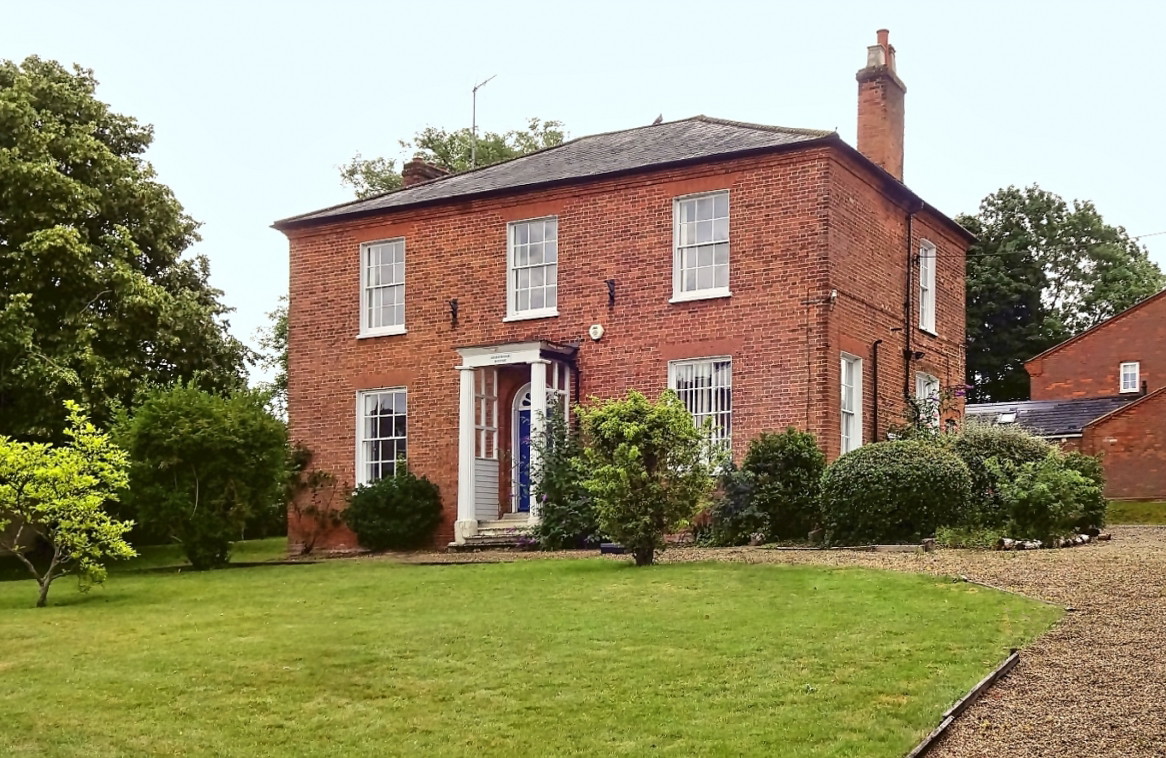
Elm House, later renamed Ardenoak House, stands at the junction of
Langdon Street
and the High Street. Now a Grade II listed building.
Beyond Griffins Lane (now Langdon Street) was a meadow extending
extending as far as Gowers Street (now Queen Street). The
meadow was owned by the Elliman family, who were drapers in the High
Street. Eventually they had a house (Westcroft) built on it
and lived there. They were related to the Ellimans of Slough,
who produced the famous Elliman’s embrocation. Before any
houses were built on this land an attempt was made to dig gravel,
but the product was not clean enough and this was given up.
The road at the Western end of this meadow became known as Gowers
Street because Mr John Gower had his house and stables built there,
but when it was properly made up and kerbed and channelled it was
officially named Queen Street.
Passing on to Henry Street we should pass the terrace of five small
cottages, each with its tiny front garden. Three of these
having been converted into shops the gardens have disappeared ,
leaving a nice wide pavement or forecourt. These cottages have
brick fronts but the back walls were mainly built of flints.
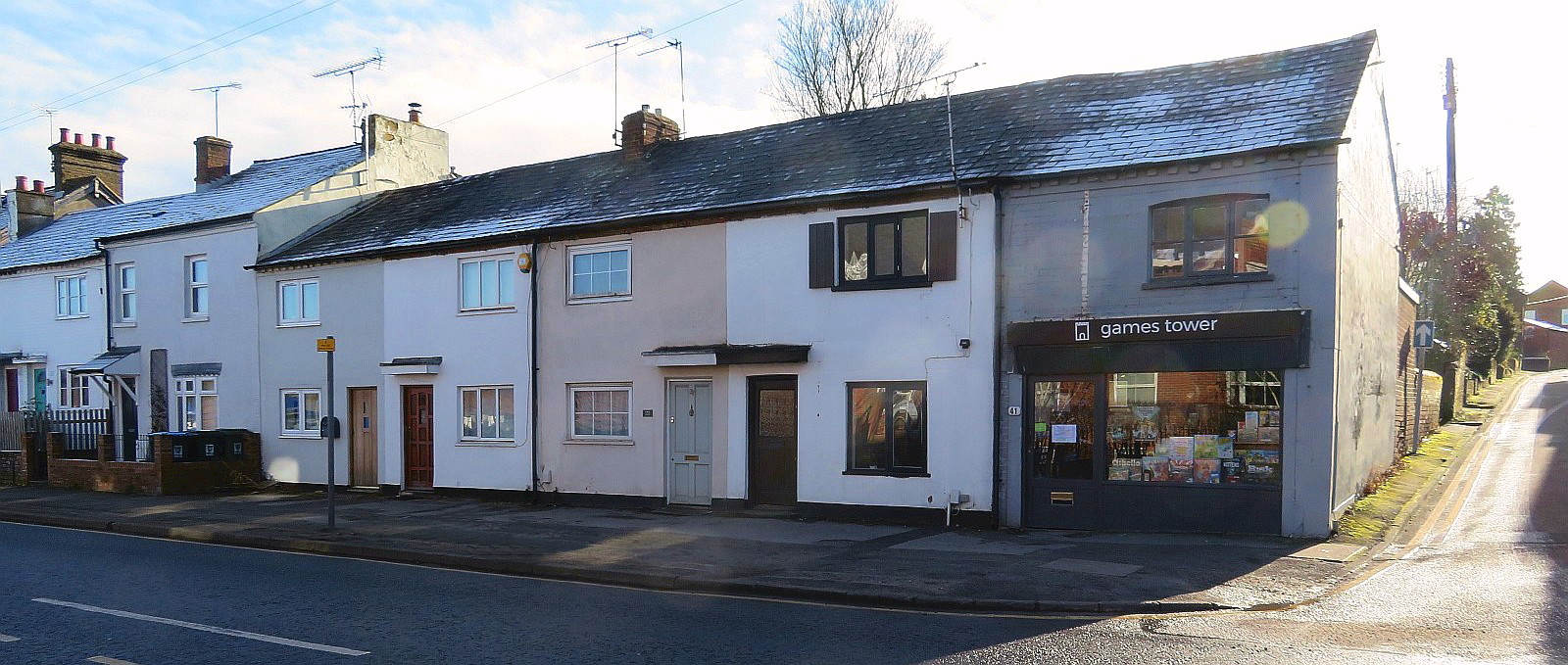
The five cottages in Western
Road.
The Baptist Chapel a few yards further on - now demolished - never
seemed to attract a large congregation, but thanks to the liberality
of two or three members was able to carry on some time after similar
chapels had closed. The house next door, demolished at the
same time, was occupied for many years by Mr Fred Rolfe, after he
moved his business from Albert Street. It is believed that the
intention was to build a good shop on this site, but apparently
something prevented this and the only result of the demolition has
been the creation of an eyesore.
Beyond Chapel Street and with its gateway in Western Road was
Fincher’s builder’s yard, with its stables , stores, machinery,
carpenters shop, etc. The boss of the business was Mr John
Fincher, but the day-to-day management was in the hands of Mr Bert
Cook, a man liked and respected by all who had dealings with him,
whether as employees or customers. Finchers had their own
brickfield at Buckland Common where they made good multi-coloured
bricks. Many of the houses they built could be recognised by
the bricks and the workmanship.
A few yards further on was Amsden’s coal yard and stables.
This was not a big business, but they always had a couple of real
good horses, and their harness and trolleys were always kept in
top-notch condition.
Near the end of Western Road on the other side of the Street, was
the ironworks of the Crawley Brothers. their business was
mainly agricultural and industrial blacksmithing and forging, and
not horse shoeing, which was done by the various farriers scattered
about the Town.
Next to Crawley’s place was Mr Parrot’s coach building works.
Most of the vehicles built here were in the light category, such as
pony traps, governess carts, wagonettes, etc. and some excellent
skilled work went into their manufacture. Both these
properties have been replaced by Wright & Wright’s motor works and
showrooms.
At the corner of Duckmore Lane was a row of cottages. In the
gable and facing Western Road was built a cross of black bottles,
bottoms outward. It was only a gimmick, but the name bottle
cross for this corner of Town persisted for many years, long after
the cottages were demolished.
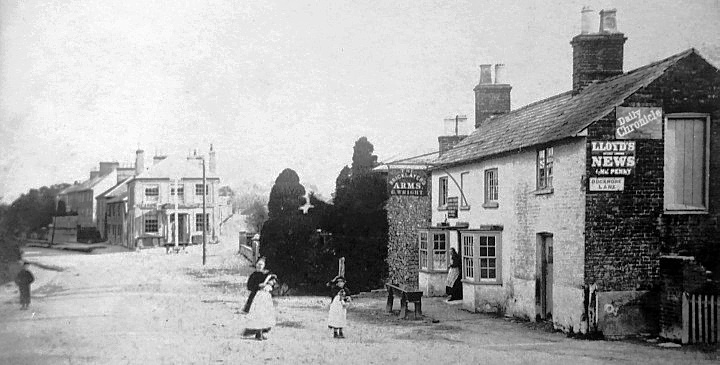
The Bricklayers’ Arms at Bottle
Cross
On the Town side of the cottages was a public house, the
Bricklayers’ Arms, and a stonemason’s yard. The land behind
these properties belonged to the Rothschild estate, and when the
site was leased it was included in the same field. But it was
a poor stony field and eventually it was planted with trees and in
due course became known as “The Spinney”. By the time part of
it was cleared to make room for Woodland Close it could have been
described as a wood. But before any of these alterations could
take place the road was narrow with a high bank and tall overhanging
hedge, and was well named Dark Lane. This was the recognised
name as far as Chapel Street after which it became Park Road.
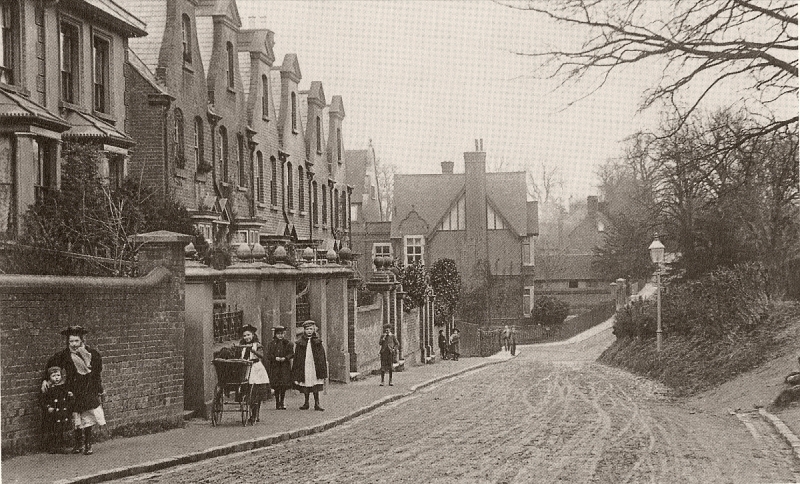
Above: Park Road looking towards
the Natural History Museum.
Photos courtesy of Jill Fowler and
Mike Bass.
Below: Park Road viewed from the opposite direction. Louisa Cottages
were extended in 1901.
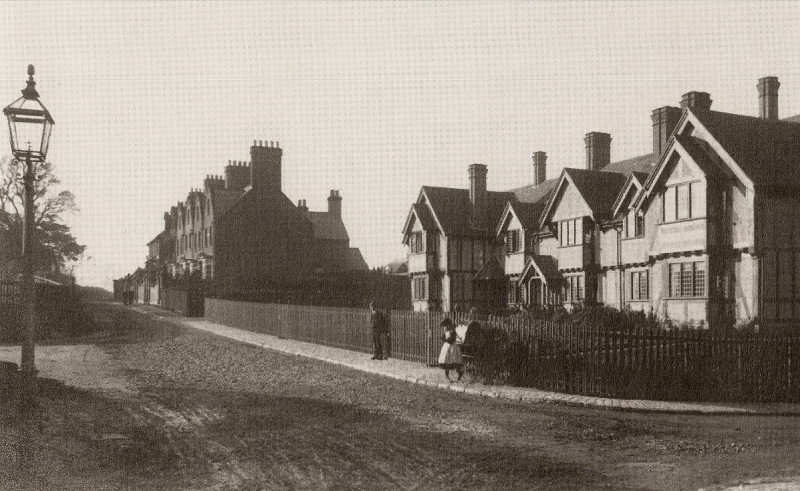
The “Furlong” was much as it is today, except that the trees in the
grounds have grown out of all proportion, some of them now being
eighty feet high, but across the road the “Weaving Shop”, which was
then a busy canvas factory, has been gone many years, and the site
is occupied by a clump of trees. The looms were operated by
middle-aged and elderly men but there was a constantly changing
quota of boys doing a job called “quill winding”. The wage for
this was half-a-crown a week, so few boys remained long but left as
soon as anything else offered.
Twenty yards up the farm road at the side was the footpath to West
Leith, but when Lord Rothschild bought the weaving shop and had it
demolished, this path was closed and replaced by the “New Path” off
Dark Lane.
About this time the farmhouse at Home Farm suffered a disastrous
fire and was destroyed. It was a freezing cold night, and the
firemen were covered with ice when they came off duty in the
morning. The present house was built a year or two later.
Almost opposite the farm drive was Arnold House, originally built as
a sort of vicarage for St. Martha’s Church. It was altered and
enlarged years ago, and named The Old House.
One of the two Downs Villas was occupied by Miss Green, and in it
she had a small select private school for young children.
The landlord of the Castle public house was Mr Lloyd. Opposite
to the castle, where now is just a bare meadow, were the substantial
buildings and playing field of
Mark Young’s Academy for Young Gentlemen, known as Prospect
House. This was a high-class boys’ school with accommodation
for numerous borders, as well as a considerable number of boys.
Although the school was still commonly referred to as “Mark
Young’s”, the head was in fact “Mr Maull”, and he carried on until
it closed and was demolished by order of Lord Rothschild.
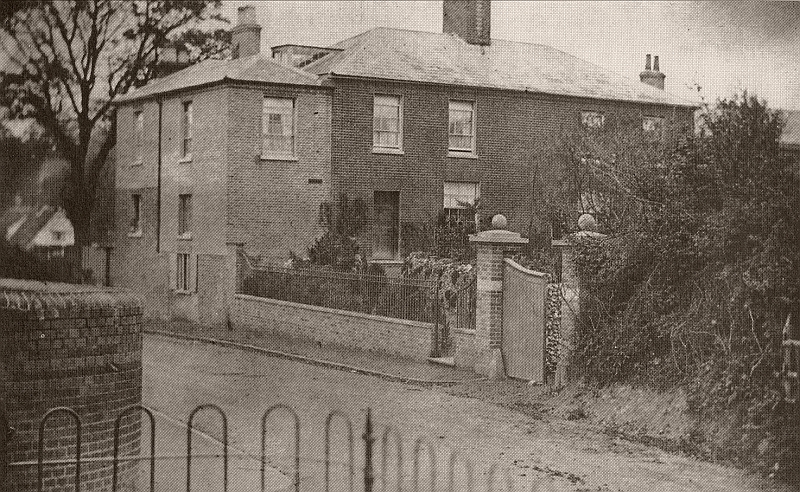
Prospect House School, viewed
from The Castle public house.
Photos courtesy of Jill Fowler and
Mike Bass.
The meadow between here and Hastoe Lane was known as Wright’s
Meadow, being used by Wright’s the butchers in Akeman Street to
contain bullocks and sheep for a few days until wanted for
slaughter. The ponies used in the business were also
“turned out ” when not required for work, and many a boy has had his
moment of glory when given a “leg up” and allowed to ride up to the
meadow.
At the other corner of Hastoe Lane the Quaker Cemetery was still
nice and tidy, as relatives of some of the people buried there were
still alive and able to take care of it. The Quakers’ Chapel
had not long been cleared away [Ed. In 1760 the “meeting”
which had previously been held at Weston Turville in Buckinghamshire
moved to Tring where it remained until 1818 when a meeting house was
built in Berkhamsted. (Source, the National Archives)], and
people still told stories of listening outside and hearing nothing
for long periods until the spirit moved one of the congregation to
speak.
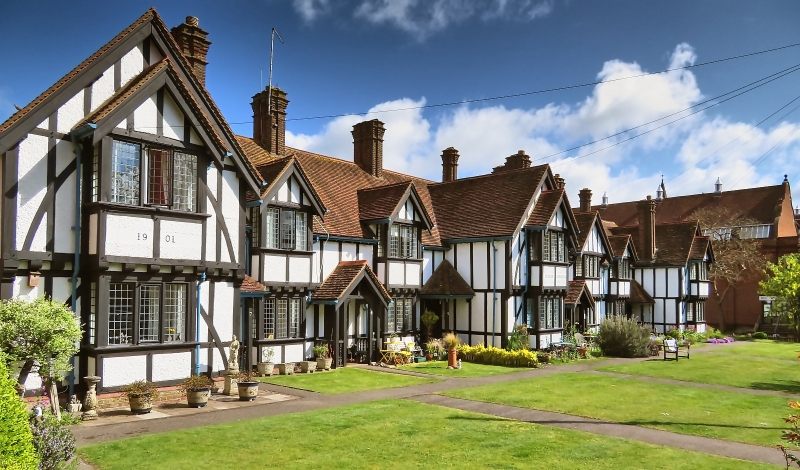
Louisa Cottages
The site of the almshouses (Louisa Cottages) was occupied by some
old cottages and a public house, the Jolly Sportsman. These
were cleared away in the tidying up of Park Road and Louisa Cottages
were built in 1892 [Ed. Nos. 1-5 ‘1893’: 6-8 ‘1901’ - see
date plaques on front bays]. It was commonly thought that
it was lady Rothschild’s idea to have them built. They were
intended for old retired employees who had worked for many years on
the Tring Park Estate. The land now occupied by the Museum was
the site of a set of farm buildings, the one facing Akeman Street
being a large black barn.
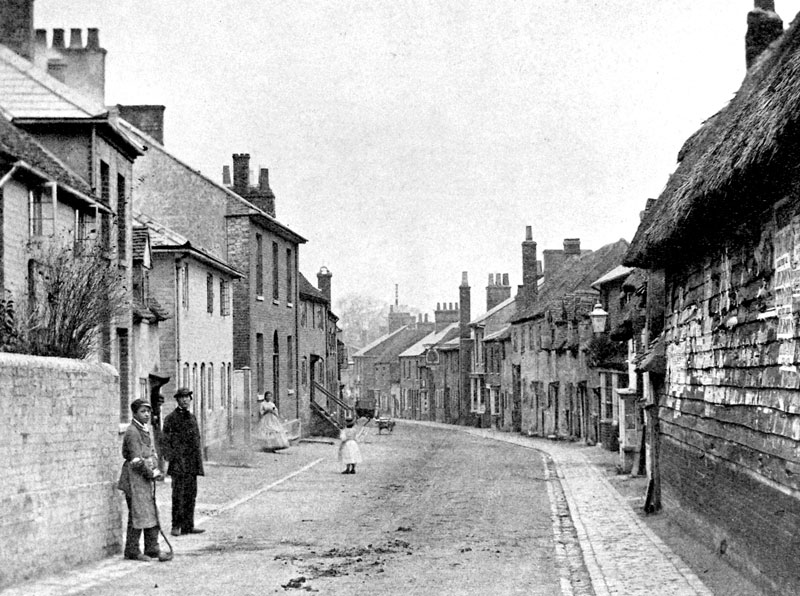
The top of Akeman Street, “large
black barn” on the right
When the Museum was built all the bricks and tiles were taken up by
hod carriers, and by the time the roof was put on it was a great
height for this. In fact it so affected the nerve of one of
the hod carriers, an older man, that he became mentally unbalanced,
and at the weekend he was walking up and down the street reciting
the Lord’s Prayer in a loud voice. Possibly he had recited it
silently to himself each time he went up with a load. Anyway
he was never able to work again.
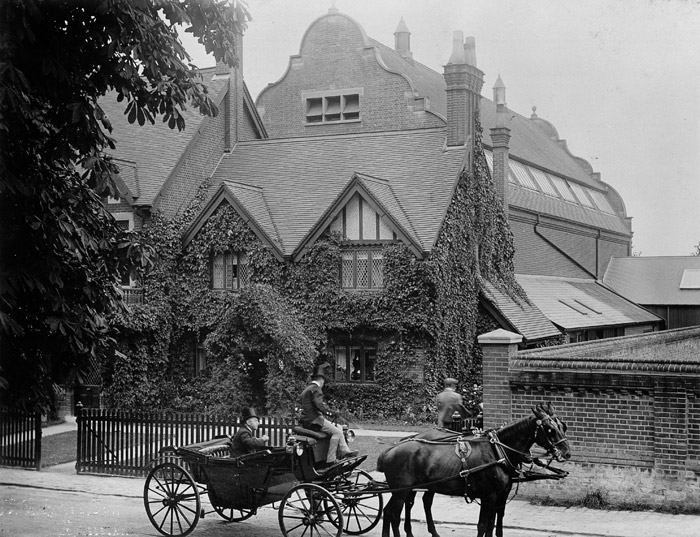
Tring Natural History Museum as originally built
Akeman Street was the most populous and busy street in the Town, and
there were about fifteen shops, some doing a considerable trade.
The first of these was Wright’s butcher’s shop, where Mr Alt
(Albert) Wright lived on the premises, and the slaughterhouse at the
back provided all the meat for this shop and Wright’s other shop in
the High Street.
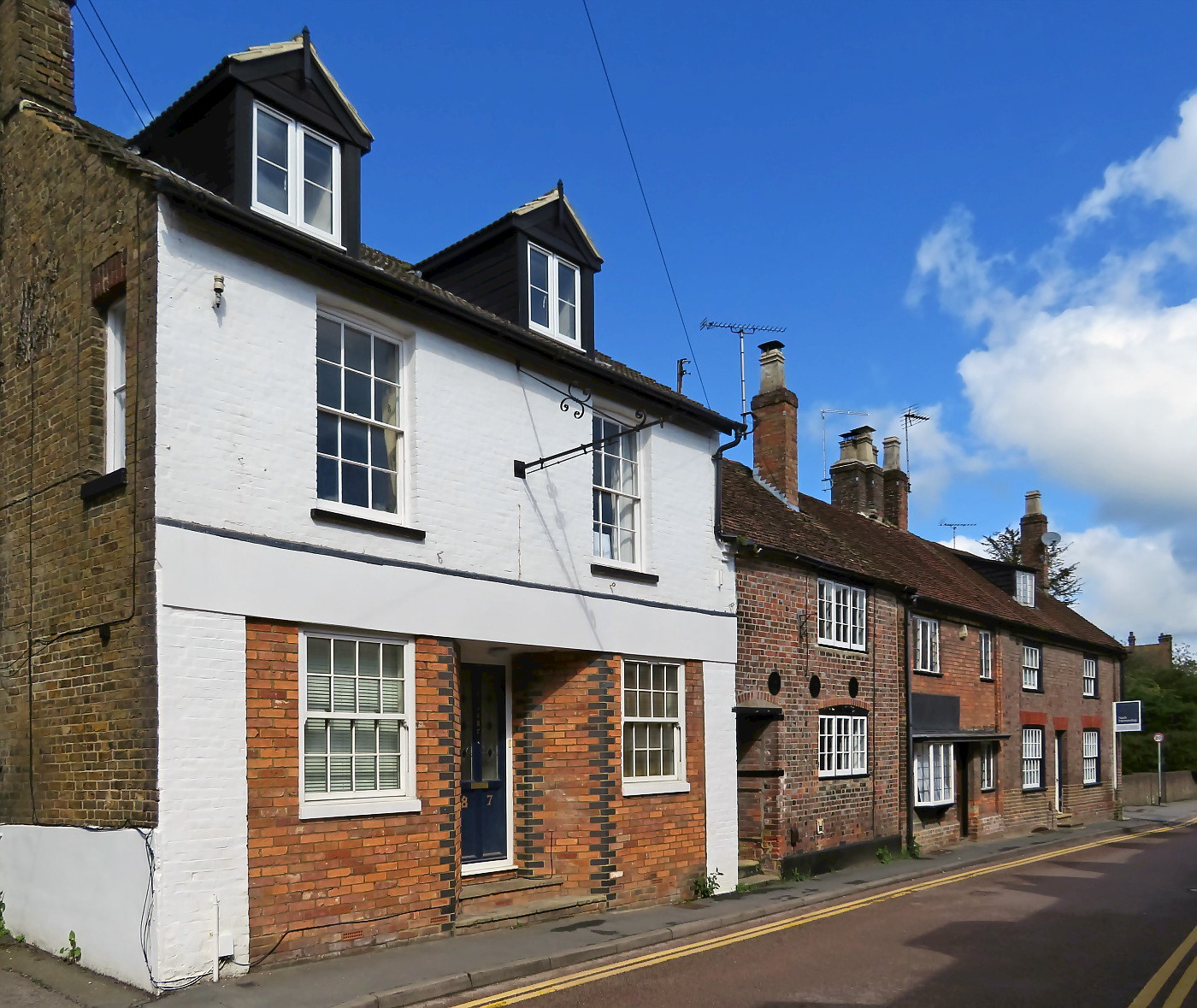
The former Swan beershop
The beershop opposite, The Swan, was a Rowsham Brewery house, and
Rowsham beer was an acquired taste, so it had its small but faithful
quota of regulars. Rodwell’s Brewery was in full production
next door, but only a small part of their beer was consumed in
Tring, being mostly sold in the neighbouring villages where it had a
good name.
Next door to the Brewery house was Wade’s shop, a general store that
sold, among other things, newspapers, including
Lloyd’s Weekly News, which came out on Friday. This
eventually became Lloyd’s Sunday News, and survived under
this name for many years, but some time ago it was taken over by one
of the other Sunday papers and that was the end of that. This
shop in later years was used for various trades, being at one time a
dairy, and at another a jeweller’s and clock shop, reverting between
times to a private house as at present.
Just round the corner in Albert Street was the blacksmith’s shop of
Mr Dan Lines, where he and his sons were busy shoeing some of the
many horses then in use in the Town, including some from
Rothschild’s stables. At this time an attempt was made
to “break in” some zebras to work in harness, and some were actually
driven by Mr Harding, the head coachman, but it was noticeable that
while they were as fleet as deer when at liberty in the Park, they
were as stubborn as mules when in harness. One would have done
as well with a pair of good donkeys.
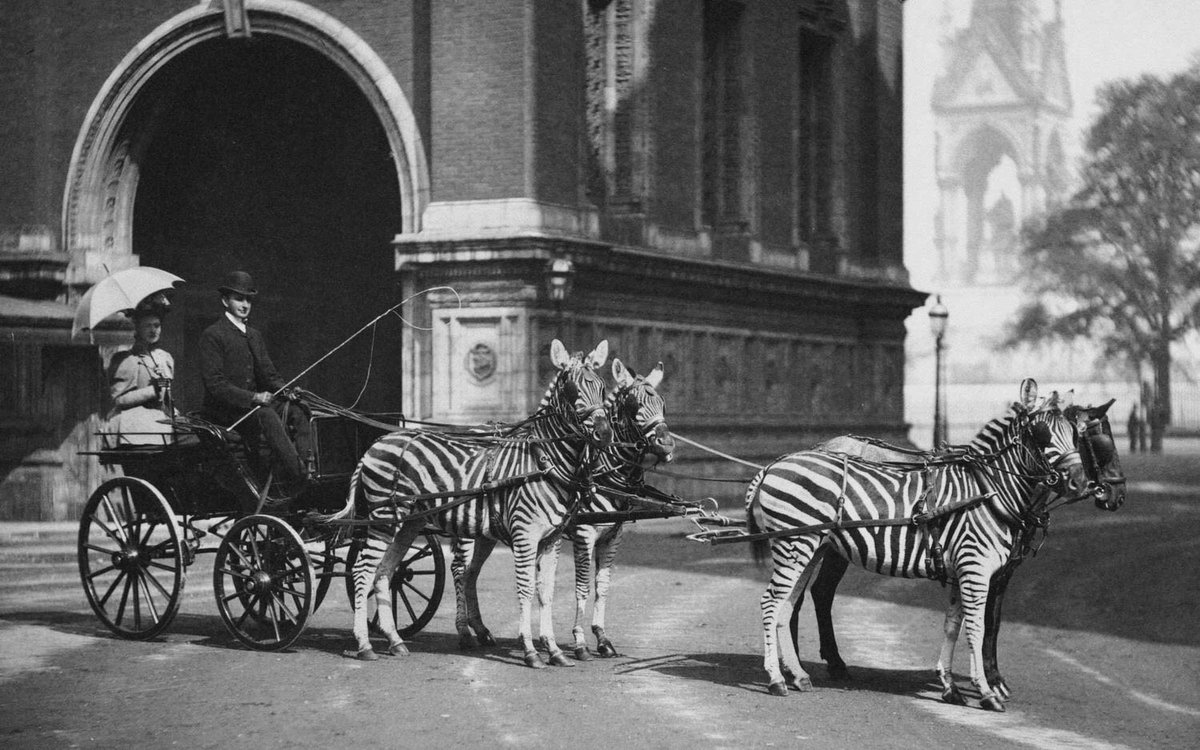
Walter Rothschild’s zebra
carriage (1898).
Nearside front is a horse, used to control the three zebras.
Opposite Albert Street was the archway leading to Surry Place, now
vanished, but then comprising seventeen cottages, all occupied, and
some of them by quite large families. It was a mystery how
they packed them all in. Batchelor’s shops were convenient for
these people as they sold a wide range of goods, from groceries and
confectionary to hardware and drapery. Mr George Batchelor
preached on Sundays at a chapel at Dunstable, and one pony (Tom)
pulled him there and back for twenty years without mishap.
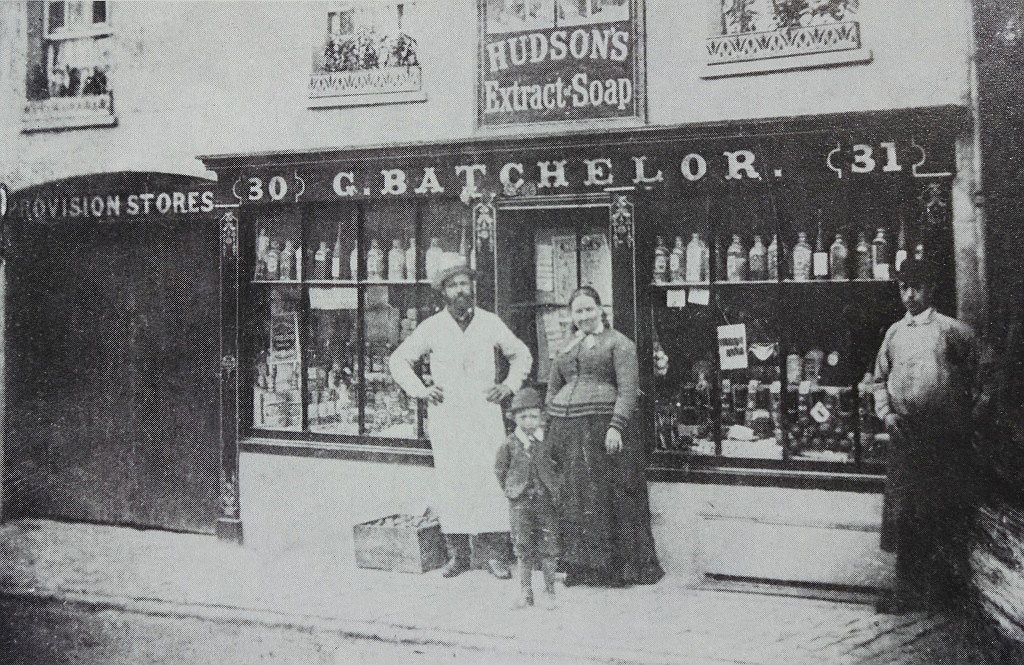
Batchelor’s, Akeman Street.
The Royal Oak next door, by Bank Alley, was kept by Mr Kemp.
This was one of the pubs that opened at 6 a.m., but it was more
notable for the “musical evenings” which occurred there.
Several times a year a party of young men would drive here from
Chesham in two or three wagonettes or a
pair horse
break and have quite a party.
Across the road from the Royal Oak, on the site of the present W.V.S.
room was a boot and shoe factory, employing thirty or forty people.
This belonged to Mr Harry Stevens, whose home was lower down the
street. Like the Chesham factories, production line methods
were used here and people used to hand-made boots and shoes were apt
to refer to this as “Chinese Labour”. Albion Place, just below
the “Snolshop” consisted of four cottages facing the street, and
four at the back of the yard. These latter had no back doors,
being half submerged in the ground.
A few steps further on came Willow Court, two cottages in the
street, two behind. One of the front ones was a grocer’s shop,
run by Mr Charley Stevens, who later emigrated to Canada.
Opposite to this was Mr Jack Rolf’s bakery and shop, a good business
with a large shop trade and a couple of ponies and carts for the
rounds. At the side of this shop was the gateway leading to Mr
John Brown’s malting. This occupied the back land behind the
properties facing the street. ~It is said that when Mr Brown
decided to have it built he retired to his room for twenty-four
hours, and worked out all the quantities in his head. He then
sent for the builder and repeated to him all the quantities of
brickwork, timber, floorboards, slates, doors, windows, etc.,
leaving only labour to be estimated. The resulting building
was a credit to both owner and builder.
To produce malt they of course needed barley, and one of the
suppliers was Mr Dawe of Wendover. It was usually delivered by
farm wagon in loads of two tons drawn by two horses, one in the
shafts and one in chains. As the gateway was narrow, and
Akeman Street not very wide, and the wagon having only a quarter
lock, it was quite a performance to get it into yard, entailing
several shunts. Once in there was plenty of room.
A few doors down the street, at No. 22, lived Mr Avery, a newsagent,
and the first to sell Sunday papers in Tring. Almost opposite
Avery’s shop was Denmark Place, half-a-dozen cottages endways to the
street with no back doors and not much room in front, being
alongside Honour’s Yard.
Back to the Eastern side of the street, Mr John Green’s general
store and off-licence (noted for the quality of their snuff).
The opening at the side of this shop gave access to The Slipe, later
known as Pleasant Row and now demolished.
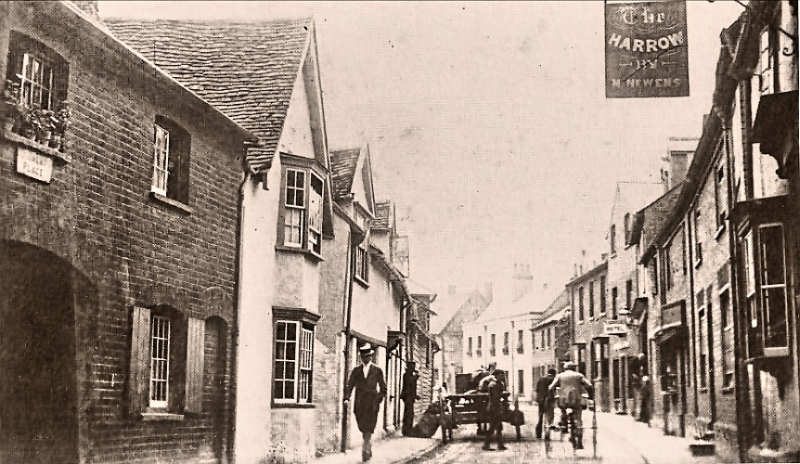
On the left is the entrance to
Clement’s Yard. On the right The Harrow public house.
Photo courtesy of Jill Fowler and
Mike Bass.
Three doors further down the street Mr Grace’s Mill, producing at
that time mainly straight meals for pig and poultry feeding, and
crushed oats for the many horses and ponies working in the district.
The modern dairy Nuts, laying pellets, and balanced feeds had not
yet been invented. The three shops opposite the Mill were Mrs
Piggot’s tea shop, Billy Bordycutt’s grocery, and Grace’s bakery (no
connection with the Mill). One of Mr Grace’s daughters had a
private school, which she carried on in the schoolroom belonging to
the disused chapel at the top of the yard, when came the name
Tabernacle Yard. Billy Bordycutt was for some years the
goalkeeper in the Tring Town Football Club.
|
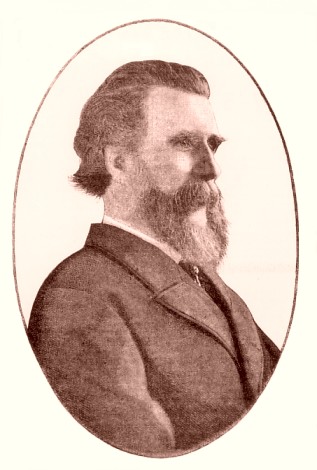 |
|
Gerald Massey, poet and author
(1828 - 1907) |
The Harrow Yard was lined either side with cottages, crammed in to
the last available foot of space. The Harrow public house was
an inconvenient old place, and never had the makings of a good inn.
Three stone steps outside the front door were a trap for anyone who
had taken “one over the eight”.
Across the street Clement’s Yard was also lined with cottages.
The one at the entrance arch had at one time been occupied by the
mother of Gerald Massey, the Tring
poet. The shop on the other side of the arch was that of Mr
Burr, barber. His prices were the same as Dan Bedford’s, one
penny for a shave and two-pence for a haircut. The sweetshop
just below was kept by May Randall and was very popular. It
has had many different proprietors since then, but has always been a
sweetshop. Of course the “Wood Green Bouncers” and “Jap
Nuggets” of 1890 have long been superseded by other confections.
Akeman Street Chapel was universally known as Glover’s Chapel, named
after Mr Richard Glover who was pastor for many years in the early
part of the century. In 1832, during his ministry, the
Chapel was rebuilt and enlarged, and is one of the few to have
inscribed on its outer wall its vital statistics, 51 ft square.
The Chapel was always famous for the quality and volume of the
singing.
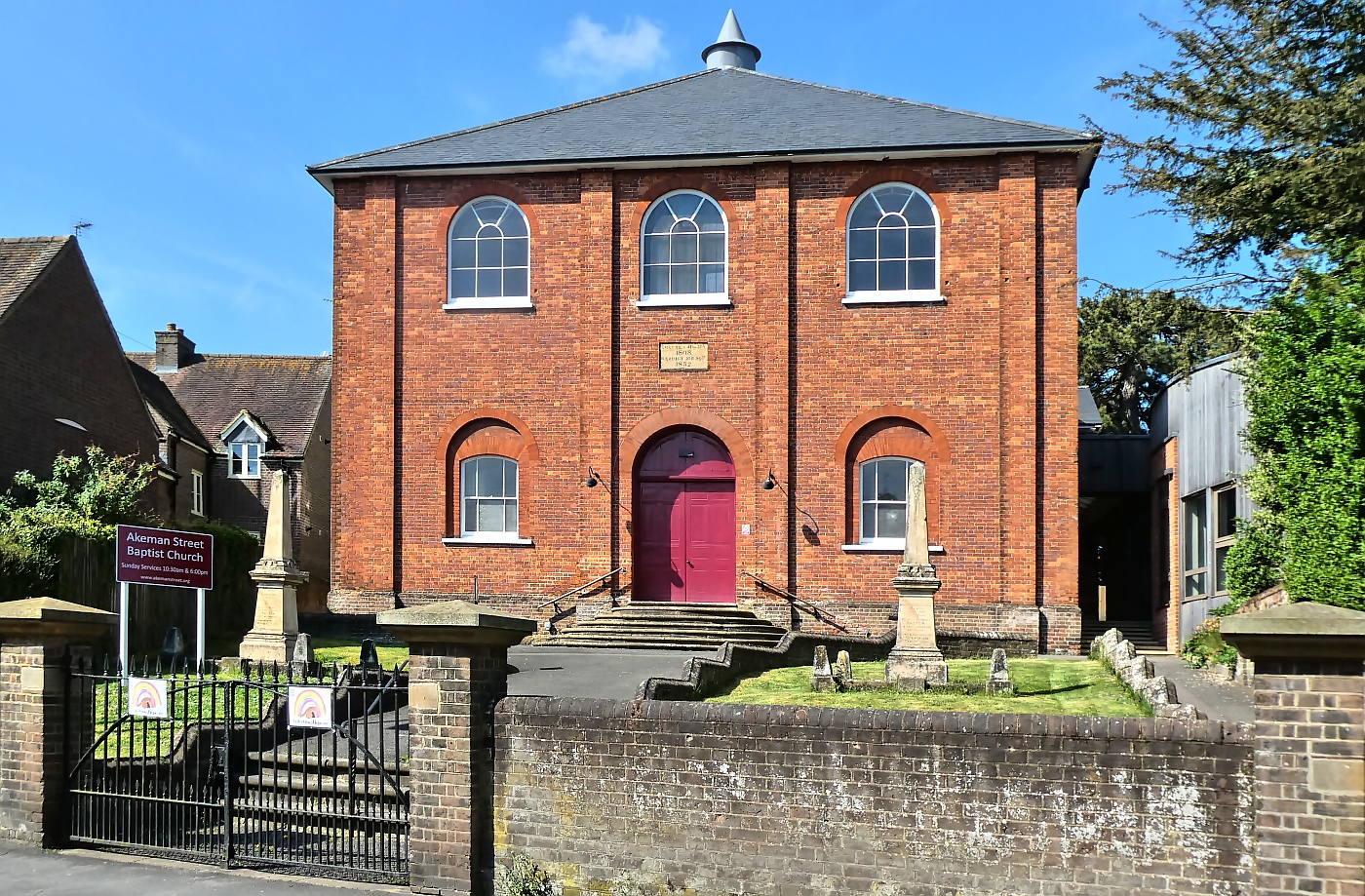
Akeman Street Baptist Church
(Glover’s Chapel)
The site of the present small car park and public conveniences was a
walled garden which belonged to Mr Butcher of Frogmore House.
With the co-operation of Lord Rothschild the wall was taken down,
the earth cast away, and the site handed over to the Urban District
Council who put it to its present useful purpose.
The Victoria hall was much as it is today, except for the fact that
the caretaker (Mr Fenner) and his family lived on the premises, in
the rooms on either side of the entrance. A very popular
occasion at the Hall was the annual Parish Tea, organised and
arranged by some of the ladies of the Parish Church congregation.
Among the most notable events taking place here were the various
balls arranged by the Rothschilds. One of the fine orchestras
who played for these was the famous “Blue Hungarian Band”.

The Blue Hungarian band were a popular draw in
Britain
over almost five decades between 1880 and the 1930s.
Between the Hall and Mr Jeffery’s back yard were three or four old
cottages which had been equipped with the old-fashioned bowed
windows.
That completes the circuit and here we are back at the “George
Corner”, having cast the eye of memory over most of Tring as it was
in the eighteen nineties.
――――♦――――
REMINISCENCES
by Joseph Budd
|
.JPG) |
|
Joseph &
Florence Budd on their
Silver Wedding day in 1936 |
I was born in November 1886, and though I did not know it at the
time, I was born an uncle, with half a dozen nephews and nieces,
some of them teenagers. The explanation is simple, really. My father,
who was born in 1826, married twice, the first time in 1846. This
wife bore two sons and a daughter, who all grew up, married, and had
families of their own. She died, however, in 1880, and four years
later he married my mother, so when I arrived in 1886 their combined
ages totalled one hundred (sixty and forty). They were wonderful
parents to me, and I also had a nursemaid who was more like a big
sister. One of my first memories of her is an occasion when she
carried me pick-a-back nearly two miles. My father had gone to
Chesham with the pony and trap, and we went to meet him so as to
ride back. Now there are two roads from Hastoe to Cholesbury. We
took one road, he happened to come the other way. Eventually we
turned back, but by this time I was tired and she carried me. When
we got nearly home we met the pony trap coming to rescue us, so we
were able to ride the last two or three hundred yards.
Nobody grumbled, no-one was grumbled at, it was dismissed as “just
one of those things”.
Another memory, before I was “breeched” concerns a new coat. I
remember it was white, with some blue facings and I was to wear it
the next day (probably Whit Sunday).
Anyway, after I had had my bath, I was dressed again and the coat
tried on to make sure it was just right. I walked about a bit to be
admired, stepped back and fell full length in the bath, on my back. I was fished out, dried, and comforted, but I don’t think I ever
wore the coat again. I expect it was spoilt.
Another early memory is of being taken to Velvet Lawn Flower Show in
the pony trap. We took a visitor with us, a cousin of mine, who was a
Colour-Sergeant in the Gordon Highlanders, dressed in his full regimental
uniform including the kilt. When we dismounted from the trap he took
my hand and led me up the field to where the Band was playing. I was
the proudest boy in the field, because I thought he was wonderful in
his gay uniform, but I had one reservation; there were thistles and
they pricked my legs.
We often went for a ride in the pony trap during the afternoons, and
one day we were at Wendover. We were told “there is a steam Navvy at
work on the new railway” so we went that way to see it. In my
minds eye I would see a big mechanical man, twice the size of a live
navvy and complete, right to his “yorks”, the leather straps round his
trouser legs. The reality was very different, just a machine with a
scoop at one end, and no resemblance to any navvy who ever lived. I
was disappointed. It was of course much smaller than the
earth-moving machines in use today.
My father used to go to Ashridge House once a week to collect
kitchen waste (dripping etc.) and often took me for the ride. It was
“open house” there, and bread, beef, and beer were to be had for the
asking. This had formerly been the custom at many country mansions,
but I think it had nearly died out and Ashridge was one of the last
to stop it.
Most of the beef was reared on the Estate and they baked their own
bread and brewed their own beer.
|
.JPG) |
|
Joseph with his
daughter Olive
on her wedding day in 1938 |
One day we went to Ashridge, not to the Mansions, but to the “Woodyard”. This was the place where the Estate carpenters worked, making field,
gates etc. There were some apple trees there and my Father had
bought the crop. He put up his ladder and started picking. There
were some inviting paths winding among the trees and I started to
explore. A little way down one path I saw a hole in the ground and
as I walked by some wasps came out and buzzed round me. I turned and
started to run, stumbled, and fell. This alarmed the wasps and
scores of them swarmed out of the nest and attacked me. I was stung
all over my head, face, neck, arms, hands, and legs. It occurred to
me when I got older that someone had an unthankful job of rescuing
me. I know I had to be brought home and there was no more
apple-picking that day. When we went again about a week later the
wasps nest had been burnt out.
From the 1st May to the 1st November each year our Pony was turned
out in a meadow each night and fetched in the morning. He was very
docile, and I was able to ride him while I was still very young. In
the morning I would walk up with whoever was fetching him and ride
back, and in the evening ride up and walk back.
The time came for me to go to school. I could have gone to the
National School infants department, but my parents preferred that I
should attend a private one. There were several to choose from, and
I was fortunate in the one they chose. I loved it from the start. I
was lucky in that I had already learned the alphabet, but the
“pothooks” and “hangers” were new to me. I soon got the knack of
them, and coasted along quite comfortably. I got some unofficial
instruction at home from my mother and my former nursemaid. The
latter also taught me the Alphabet backwards, in a metrical version.
It ran ---------- Z Y X and W V
U T S and R Q P,
O N M and L K J,
I H G,
F E D, and C B A.
It was a lot easier to learn than the right way version. I also
learned about this time the jingle:
Tring, Wing and Ivinghoe
Three Churches all in a row
I could take me shoes and stockings off
and jump over ’em. |
At the top of Akeman Street, on the site of the present “Louisa
Cottages” there stood at that time a Public-house, the “Jolly
Sportsman”, and some old cottages. Lord Rothschild bought the lot
and had them demolished. The timber was carted away, and the bricks
cleaned and packed up in stacks of a thousand each. This made a
wonderful adventure playground for the young children of Akeman
Street, and many were the hours we spent there.
All too soon the site was finally cleared, and “Louisa Cottages”
built to serve as Almshouses for old employees on the Estate after
they finished working.
The year was 1892, and I believe they bear the date somewhere.
One afternoon while we were still playing there, we heard a noise,
and looking down Akeman Street saw quite a number of people
congregated near Surrey Place. Being, like all children,
inquisitive, we teamed down there to find out what the commotion was
all about. The answer we got was “Rough Musicking; go and ask your
mother for something to make a noise”. We didn’t know what the idea
was, but we could make a noise alright, and did so, running about
among the people like dogs at a fair.
When I was two or three years older I asked my parents what it was
all about, and they explained.
A certain woman who lived in Surrey Place had earned the reputation
of being a “Scold”, yet had the impudence to take out a “summons”
against her husband, alleging cruelty. The neighbours couldn’t stand
for this, so they conspired together to spoil her case. Some of them
volunteered to appear as witnesses on her behalf, and actually went
to the Court, but when they gave evidence they testified that the
Husband was the most harmless and inoffensive man possible, and that
any quarrels or rows between the couple were entirely the fault of
the wife. The case was dismissed, of course, and the “Rough Musicking” was intended to show what the neighbours thought of her,
a sort of feminine tar and feathering.
Among the noise-making implements were an old bugle, tin trumpets,
tin tea trays, and oil drum, and a large wooden packing case. I also
remember someone fetching a gallon of beer from the Royal Oak public
house (they were open all day).
It was about this time the Museum was built. The site had been
occupied by a set of farm buildings, the one on the street frontage
being a long black timber barn which had several knot-holes very
convenient for little boys to peep through. All these buildings had
been cleared away, and the new construction grew and grew, and
eventually the hod-carriers were taking up the tiles for the roof. By this time it seemed a great height to us, and also to the
workmen. One of the hod-carriers broke under the strain. He was an
older man, and one week he spent all Saturday afternoon walking up
and down the street reciting the Lord’s Prayer in a loud voice. He
never worked again.
We saw so much horse-riding that every little boy’s ambition was to
do likewise. Every morning, soon after seven o’clock, the riding
horses from the Mansion went by on their morning exercise, about ten
grooms each riding one and leading one. These were from the “Hunting
Stables”, the carriage horses were kept in another lot of stables
and had their own grooms. These carriage horses were all roans, and
were used in matched pairs and four-in-hand teams, the latter
usually driven by Mr Harding, the Head Coachman. In after years I
saw other “four-horse men”, but never one as neat and capable as Mr
Harding. He always drove with the four reins in his left hand
“with
a finger for each rein”, and steered with his right hand.
In
addition to all these horses, Mr Harding was also responsible for the
care of half a dozen Zebras which Mr Walter Rothschild had bought. When they first arrived they were turned loose in the Park with the
Emus and Kangaroos, but in such a big bit of ground they were wild
as hawks, so they were caught again and moved to a small meadow up
Hastoe Lane, known as “Gibbs’s Close”. Here they had the company of
a dun coloured cob, about the same size as themselves, about 14½ or
15 hands. They soon began to follow him about the meadow, and
became much more docile. I suppose they recognised his superior
intelligence. Two men were detailed to look after them, so that they
did not get alarmed by strangers, and it was not long before one or
two became quiet enough to wear harness. After a few days they could
be led, one at a time, side by side with the horse, and presently in
the same way “shut in” to a pair horse wagonette. The horse being
well trained would go on either side of the pole, so it was possible
to train a “near-side” Zebra and an “offside” one. It was noticeable
that the horse did most of the work, whichever he was with. Still
the day came when it was possible to drive the pair of Zebras
without the horse.
An effort was made to train a four in hand team but the nearest they
got was two Zebras for wheelers and one Zebra and the horse for
leaders. This necessitated four grooms on foot to lead them, and two
of them had to break the eleventh Commandment. Everyone knew that
you should never attempt to lead a horse from the off side. The
Coachman was on the dickey seat, holding the reins and driving the
team to a certain extent, but it was a clumsy, fumbling sort of
progress. It did not seem likely that they would ever be “useful”,
and also they were terribly expensive.
Once or twice a year a man came round with a “drove” of thirty or
forty Welsh cobs and ponies, which could be bought at prices from
about eight to ten pounds upwards, and these when “broken in” were
real working animals, and would probably do good service for fifteen
to twenty years, and in some cases even more. They were of course
quite wild having been bred on the Welsh Hills in a state of nature
and just rounded up and driven across country like a flock of sheep.
The high spot of this affair came when someone among the onlookers
showed interest in one particular pony, and the man in charge sent
one of his lads in to fetch it out. It was just about like trying to
fetch the ball out of a Rugby “maul”, but sure enough in a couple of
minutes out he came, the pony with a halter on, and ready to be run
up and down the street a few times to show his action. Seller and
buyer would then adjourn to the nearest pub, and settle the deal
over a couple of pints.
For less excitement but more entertainment there were the occasional
German Bands, with their programmes of mostly Marches and Polkas. Some people spoke of them with sarcasm, but they were generally very
good. It did not seem possible that it could be worth their while to
come, yet some of these bands came, year after year, during the
summer. They usually had about ten or twelve musicians, and they
might change three or four from one year to another, but some could
be recognised. There were two lodging houses in operation, the Black Horse and the
Red Lion, so they were alright for accommodation. At both the charge
was sixpence per night for a bed.
Another lot of foreigners would be a party of either Russians or
Poles with a “Dancing Bear”. Of course, the bear didn’t dance, just
shuffled about on its hind feet. People laughed at the clumsy
antics, and I probably did so when I was very young, but one day
when I was seven or eight a bear looked me in the face, and the
pitiful look in his eyes made such an impression on me that I never
watched another.
There were of course many other itinerant entertainers, and one turn
that always attracted notice would be a man doing a “One man Band”
performance. The instruments might vary from one artist to
another, but an essential in every case was a set of Panpipes tied
in front of the chin in such a way as to not need a hand. A drum on
his back was struck with a drumstick tied to one forearm and
projecting back a foot or more. Above his head would be a pair of
cymbals, and these were worked by a cord attached to one heel. As
mentioned above, different men found different ways of using their
hands.
Two quieter occupations were those of “Sword-swallower” and
“Fire-eater”, both of which were rather spectacular, and never
failed to “astonish the Natives”.
Not many weeks passed without a visit by one or more street pianos,
commonly (and incorrectly) called barrel organs, and street singers
were also plentiful. Altogether it is amazing how many people got a
living without doing anything useful. Take a Knife thrower, a Rope
spinner, or a Contortionist, their turns were clever, but no-one was
any the better for seeing them.
In addition to all these, there were a number of “travelling people”
who did provide useful services, for instance, the knife sharpener,
colloquially known as a “razzer grinder”, though a razor was the one
edge tool for which his grinding barrow was not suitable. If a gipsy
took up this trade he usually had a couple of side lines, namely
clothes pegs and potato nets, probably hawked from door to door by
his wife. If one of the nets happened to come out a size larger than
normal, and if it somehow happened to find its way down a rabbit
hole, and if by chance a rabbit went down the same hole and was
caught in the net, well, that was one meal provided for.
I once saw a gipsy stop at the local butcher’s shop, and he asked
the proprietor if he could “do with a good rabbit”. On receiving a
favourable reply he took two bags into the shop and emptied
twenty-six rabbits on to the floor. The butcher commented “Not bad
for one nights work”, to get the indignant reply “Two nights”. The
price paid was eight-pence each, and they would retail at about a
shilling.
A few years later this same man camped again on Aldbury Common, and
was sitting by his fire one evening when he had an epileptic fit. He
rolled over and one leg went on the fire and stayed there. By the
time someone found him the leg was so terribly burned that it had to
be amputated at the thigh, and he was on crutches for the rest of
his life.
Other fairly regular callers were mat menders, repairing coconut
mats; saw sharpeners; chair caners; and “much fakers” (umbrella
menders), and during the summer, fly-paper men. These latter
generally wore an old top hat with a flypaper round it, business
side out and covered with flies, which abounded everywhere. They
were harboured to a great extent by the horse-dropping with which
every street was liberally littered.
Every year about the 1st of May we were entertained by “Jack in the
Green”. If the first happened to be Sunday the event moved to
Saturday.
This show was organised by the local chimney-sweeps, two families
who were in stern competition all the rest of the year, but
co-operating on this day.
One of the party played a melodion, and the rest of the party
“danced” to the music. The centre of it all was the “Green”, a
bee-hive shaped construction of hazel rods covered with boughs of
green leaves, inside which was concealed a strong young man. He held
the whole thing clear of the ground, and revolved in a more or less
stately manner, while the rest of the party danced (or shuffled)
round him singing the “Sweeps song”. This went to the tune now
called Shepherds Hey, and had several verses, after each of which
was sung the refrain -
The first of May, the first of May,
Sweeps go a-dancing all May Day. |
They may have started out intending to dance all day, but they
collected coppers from onlookers in each street, and as there were
twenty-three public houses in the town, open all day, and beer was
two-pence a pint, some of the party would be the worse for wear by
mid-day, and the show petered out.
One Mayday I remember in particular was that of 1895. One of the
boys I played with, about my own age, had a little sister about five
years old, and when I went indoors for something she was there with
my mother. She had come to show her “Maypole”, a posy of flowers on
a stick. We duly admired it, and just then the sound of music came
from outside the kitchen window. On looking out we saw it was Jack
in the Green and his gang. As she had never seen them before I was
told “take her out and let her see them properly”. I shot off,
expecting her to follow, but then I had one of my first lessons in
etiquette, I was told “hold her hand and take her out nicely”, which
I did. We watched them for a few minutes, but she wasn’t struck with
them because their faces were blacked. Of course I had seen it all
the year before so I was not supposed to be impressed.
Two or three other boy playmates of mine had sisters and it seemed
to me as an only child that they never appreciated them as they
should have done. Most of them belonged to one or other of the
various Sunday Schools, the choice depending on which sect the
parents were suppose to belong to.
I was in an odd position, my Father being a Baptist and my Mother
Church of England, so I was taken to Akeman St. Chapel on Sunday
mornings, and to Church in the evenings. I never joined any of the
various subsidiary youth organisations, yet I was invited to some of
their outings, (subject to paying my fare). For instance, the Band
of Hope attached to High Street Chapel went by excursion train to a
musical festival at the Crystal Palace and I went with them. The
fare was half a crown. When we walked through the grounds we boys
were impressed by the life-sized models of prehistoric monsters,
(made, I believe of concrete). We now learned that for a hundred
million years the world was ruled by the Mastodon, the Iguanodon,
the Pterodactyl and other similar creatures long before the human
race existed. It was difficult to imagine a world without people,
but we had to believe it, because the various plaques said so.
Presently we trooped off to the refreshments tents, bought bottles
of ginger beer, and ate our sandwiches. Afterwards we were
shepherded into the Crystal Palace itself and the actual Musical
Festival. After some speeches several choirs sang different items
which they had learned and practised, all being rewarded by polite
applause. Toward the end some of the choirs were mustered into one
Choir of five thousand voices, accompanied by the organ. After
singing three or four pieces they ended with the Halleluiah Chorus. Young as I was, this item made an impression on me which I have
never forgotten. At the time, about 1895, I had never listened to a
phonograph record, probably I had never seen a “talking machine”,
and the only way one could hear a great number of people singing was
to hear it live. In all ways it was a day to be remembered.
About the time the little school I attended closed, and it became
necessary for me to enrol at the National School in the High Street. Boys who already went there told me such dreadful tales about The
Stick (the cane) that I was a terribly worried little boy on the
Monday when I started there.
To my surprise the people were quite kind and after doing some
reading and writing and answering some questions I was put in
Standard Three. This was too easy to last, and after six weeks I was
in Standard Four. I remember the poetry lessons in Three were a
piece called “Lord Ullin’s Daughter”, which suited me fine, as I
happened to learn it at home some months before, off my own bat. I
believe the author was a gentleman named Campbell, anyway I still
remember some parts of it. For instance, it began —
A Chieftain to the Highlands bound
Cries, “Boatman do not tarry
And I’ll give thee a silver pound
To row us o’er the ferry”. |
It went on for about fifteen verses, some of which I have forgotten,
but the last verse runs —
’Twas vain, the loud waves lashed the shore
Return or aid preventing
The waters wild went o’er his child
And he was left lamenting. |
As I joined Standard Four at the beginning of a new school year I
was starting level with the rest of the Class. I soon found I was
well able to keep up with the rest of them, and the thrill of
learning something new all the time encouraged me to do my best. Also, I had seen a couple of boys caned in front of the Class, and
the fact that, in my opinion, they had asked for it made me the
more determined not to follow their example. As a matter of fact I
was never caned, but the fact that the cane was there, and could and
would be used if necessary made it a powerful deterrent any time one
was tempted to do something one knew was wrong.
Of course were were not at school all the time, and there was plenty
of time for games in the evenings and on Saturdays and when the
Summer came a good deal of our spare time was spent in the Woods. I
should think we explored nearly every yard from Stubbins Wood to the
Crong.
About this time my grandfather, (my mother’s father), was pensioned
off from his work. He had been employed by the
Grand Junction Canal
Co at their Bulbourne works for nearly fifty years, but was still
active and well preserved. He often took me for long walks, and
pointed out the particular spoils to be gathered in the different
seasons and in the different fields and woods. For instance,
primroses in Evans’s Spring, bluebells in Grove Wood, foxgloves in
High Scrubs, and white violets on the bank of Grimes’s Ditch, (Grimsdyke). Blackberries and hazel nuts from most of the hedges in that part,
and dog-daisies from the dogdaisy field, which was called “Gadmer
Park”. Strawberry Wood lived up to its name and it was possible to
fill a small basket, yet the other Woods produced hardly any. Near
the top of Pavis Wood was a spot, about twenty yards each way, where
Bee Orchids grew. For wild raspberries the most favoured place was
Wick Wood, though there were others.
Ed. At this point Joseph’s reminiscence reaches an abrupt
end.
――――♦――――
A WANDER AROUND THE
SHOPS OF TRING
in the 1920s & 30s
by Nora Grace
The following is not a fully worked up piece
of prose, but notes used by Nora Grace to support a talk that
she gave under this heading at the Victoria Hall on the 6th March
1996. Although sketchy, they continue Joseph Budd’s account of
Tring as it was some 30
years earlier and as such should be interest to
anyone wishing to know more about Tring’s retailers in the period
covered. Some of the shops which Nora used in 1996 as landmarks - such as Victoria Wine, Dennis’s
(a saddlery) and
The Motorists’
Centre
- are now
gone, but what Nora’s
notes reveal is that in the 1920s & 30s Tring had many more
shops than today selling a wide range of goods. Some of
the photos I have used to illustrate the piece relate to a
different era, but as is often the case in local history it’s
a choice between using what exists, or nothing.
I would like to tell you all that you are going on a tour of shops
that were in Tring when I was a nipper.
I am going to start at the top of Longfield Road, where Hockneys had
their greenhouses and you could buy tomatoes, carnations and a few
chrysanthemums when they were in season. Hockneys had very large
greenhouses there and the Station bus used to collect the carnations
every day at 3pm and take them to the Station. Across the road there
was George Elvy the baker, and if you want to know how many bakers
there were in Tring you better start counting. There were a lot.
George Elvy was on the corner and I have been told this afternoon
that the house is now called ‘The Old Bakery’.
Further along Longfield Road on the left hand side there was Wright’s
the bakers. No shop there now. Then you come down to the corner
(junction Longfield Road/Miswell Lane) where Mervyn Bone is now. That was Fanny Hopkins. Fanny Hopkins was a character, a real
character. Every Monday she had a horse and cart from Gowers and she
went round the houses, she used to go to my Granny and collect the
orders and every Friday she used to deliver them. It was quite a
thing to see the horse and cart come up with the order. It only came
to five shillings the whole order, but she used to pay to do this.
Then in Beaconsfield Road, much later than that, Cyril Batchelor had
a General Stores. Coming down Miswell Lane you had Hedges shop and
before you got to the shop you had the nursery where he used to grow
a lot of plants and things.
Where the Surgery is now (Rothschild House, Western Road/Chapel
Street junction) first of all was Potters Paint shop, then it became
an upholsterers, I can’t remember the name but I think it might have
been Cook’s, somebody Cook. Then it became Wilkins ironmongers. Next
door, across the road where the Chemist is now, was Venning’s Fruit
shop. Next to that was Sayers men’s hairdressers.
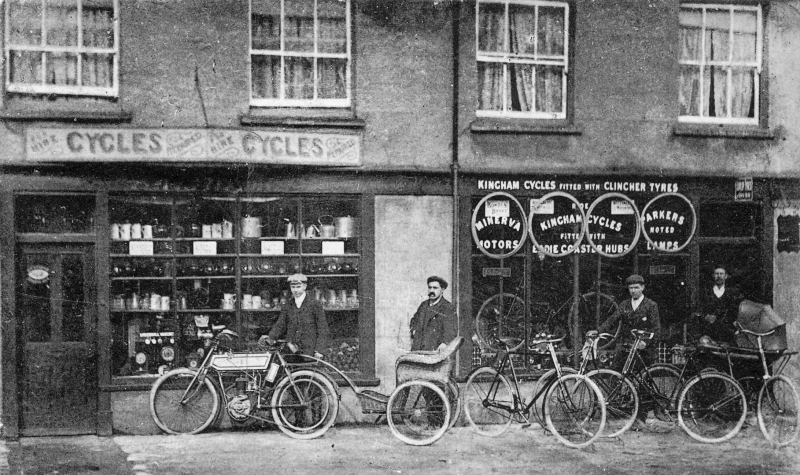
Kingham
Cycles, Western Road.
Then you go across the road (Western Road) where Atkins is now and
that was Heath’s Dairy. That later became Pat Gowers father’s
General Stores and now it is Atkins the Bakers. Then there was
Grace’s the Bakers, no relation, but another Frank Grace and he had a
shop before you got to Howlett’s the Bakers. After Howlett’s you came
to Benny Kingham’s. Now Benny Kingham had the old penny-farthing up
outside at the top of the shop and he repaired and sold bicycles. He
was a very keen Scout. Next door was Young’s sweet shop which became
Wallis’s
sweet shop. Then you had the Bus Garage which had a waiting
room where first of all was Miltons Hairdressers and then McGees
corn merchants. Now you have the Post Office there.
|
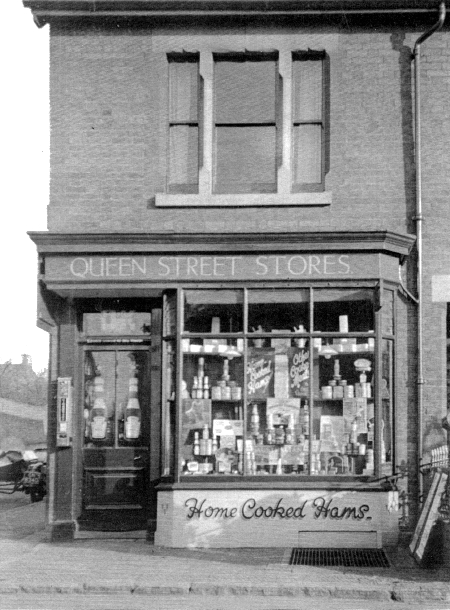 |
|
Queen
Street Stores C.1950s. |
I suppose I better go back across the road. At the bottom of
Henry Street was Austins the Butchers. Some of you remember the “Tea
Caddy”, but before the Tea Caddy it was Bob Blys’ furniture store.
Then there was Queen Street stores at the bottom of Queen Street and
now you come to the High Street, which was, until I can’t remember
what year, Western Road. It was all Western Road right down to the
crossroads, now they call it High Street.
Cross the tailors was on the corner which became Burche’s.
Tring Newsagents in my youth was Jacklin’s and old Mr Jacklin had a
men’s hairdressers out the back. If he was cutting somebody’s hair I
don’t know if you waited or the man having his hair cut waited. He
managed to serve both at the same time somehow.
Next door was Thorpe the grocers where the saddlers is now. Then it
became Jones the saddlers. I am trying to tell you where I am by
going back to today. The florists was Castle’s sweetshop. Old Mrs
Castle used to make very nice custard ice cream and you used to be
able to have a ha’penny cornet. Next door was, where Victoria Wine
is now, was Sharman’s ladies outfitters. It became Will’s, it became
Luck’s, it became Woodman’s and now it is Victoria Wine.
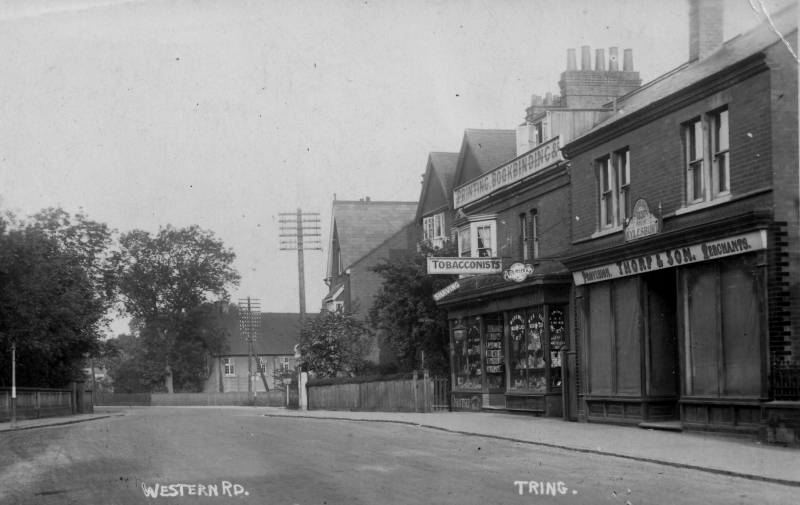
Tring
Newsagents (Jacklin's) and Thorp the grocers, with
the turnoff to Christchurch Road and Old
Church House in the distance.
|
 |
|
Grace's Ironmongery. |
Then there used to be the School. Next door to the Boys’
School
playground was Cash & Co, boots and shoes. They provided very cheap
shoes in those days. Next door was Morrison’s the Chemist. Then you
had the Solicitors, the Con Club (Conservative Club) and then
Grace’s, which has always been
an ironmongers, and then the
International Stores. I was expecting Ron Neale to be here. It was
his father-in-law who was the last manager.
Then across the Akeman Street/Frogmore Street crossroads on the
corner where you have The Motorists’
Centre now, was Gates’
toy shop. They sold a lot of other things beside, but mainly toys. From there,
next door two Miss Finches had a sweet shop and you could have
fourteen soft toffees for a penny. It is funny how these things
stick in your mind far more than the expensive things. That became
Goddard’s sweet shop.
After that you had Miss Smithson with her wool shop. You had
Greening’s the tailors which became Vernon’s. Jones the saddler,
before he moved up further. Batchelor’s the ironmongers and I have
just bought one of these little books (A Glimpse into Days Gone By)
and I have seen this thing
“The High Street is narrow,
To loiter there is wrong,
But watch my bargain window,
And you’ll be inside ‘ere long.” |
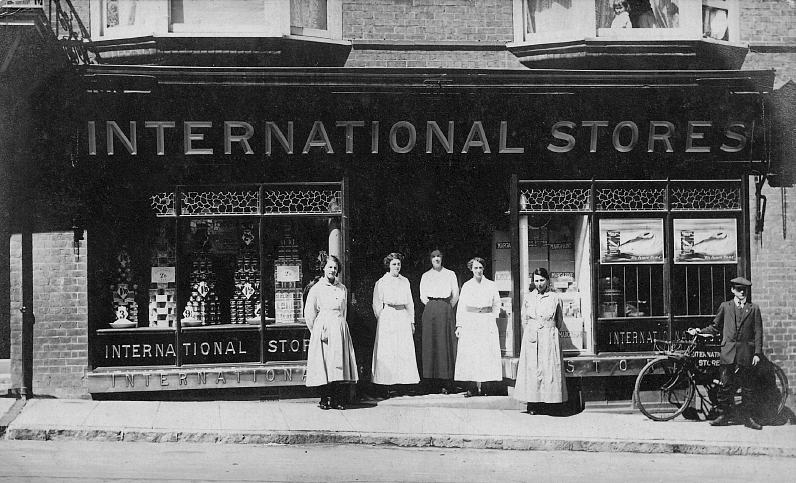
Top: International Stores, next door to
Grace's.
Below: Sanders, Fruiterers & Confectioners. To the left is Clement,
watchmaker & jeweller.
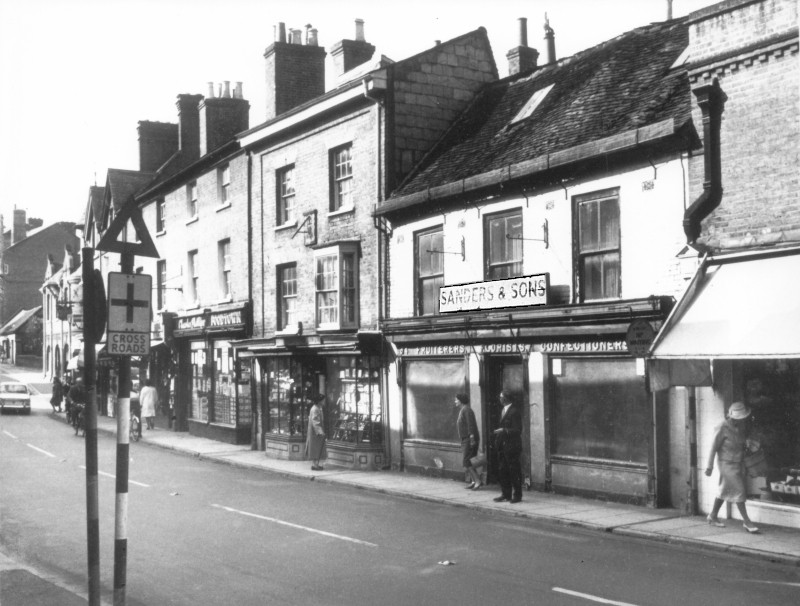
And then you had Clements the watchmakers and then Sanders the fruit
shop. It was a large double window shop with fruit one side and home
made chocolates etc. the other side. Then the London Central Meat
Company.
Then you come to The Bell. Before you go into The Bell you have The
Bell yard. In that yard for some years was a fried fish shop. I
don’t know how long it lasted, but it was there for some years. I
can remember a story about somebody, I won’t tell you who, but you’d
know him. I was down with a friend one evening and Gran said we’ll
have fish and chips. So, Don went off, to get this
fish and chips and he was ever so quick coming back, but we knew
every Friday evening there was a queue. He walked in very smartly. Everybody looked up and said how did you manage it. He had got a pin
and he had pricked his way to the front of the queue. Unfortunately,
he died last year.
Then next door to The Bell we had Miss Foskett with her parents
first of all, then Miss Foskett with a shoe shop. They were
the expensive shoes. You had K shoes, your best shoes were for
14/11d, get a pair for 12/11d. I am sorry I have gone wrong,
Toddy Ives came first next to The Bell with all his glamorous ladies
wear. Double fronted windows and then Miss Foskett and Wrights
the Butchers. Old Mr Wright was always seen at eleven o’clock
religiously. Grandfather Wright this was, puddling his way
over to The Rose and Crown, nobody ever knew what for.
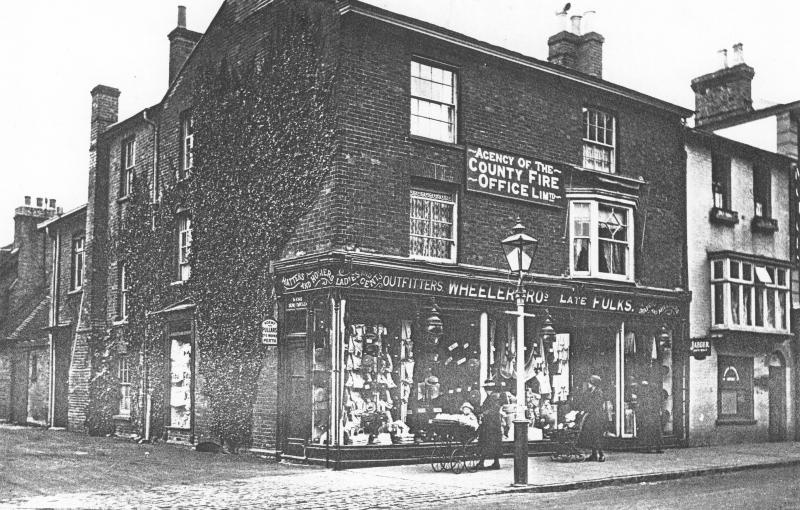
Wheeler
Brothers, outfitters, Church Yard and High Street.
Going down by the Church - where Michael Edmunds now has his Estate
Agency - Blys had a shop there for some years. You go past the
Church and you came to Wheelers. Now Wheelers had a men’s
outfitters, ladies outfitters, hats, coats, you could buy
everything. You can’t buy anything like that now in Tring.
Next door to that was John Bly and then you had Robins and Marriott
who were car people and during the last war it became a naval depot
and now of course it is Metcalfe’s ironmongers. Where the shop
is now next door was Fulks the grocer.
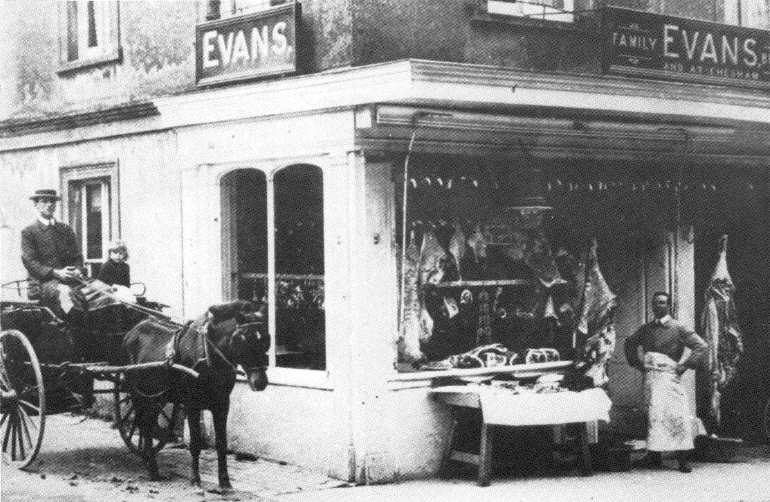
Top: Evans butcher.
Below: Gowers General Store.
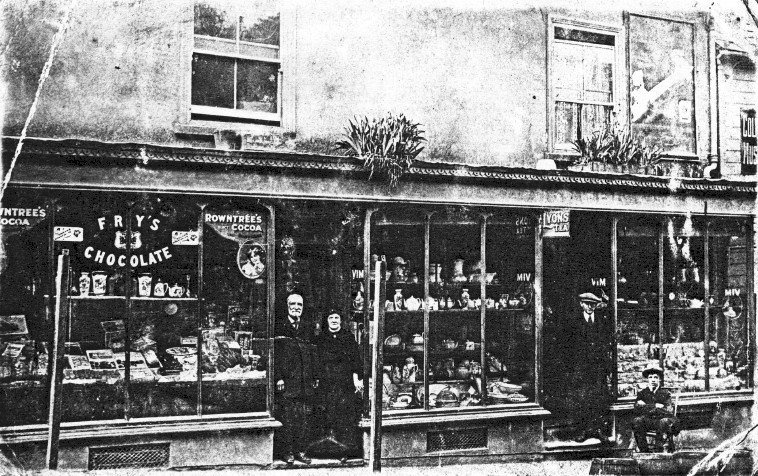
Sunspa, as it is, was Evans the Butchers, which then followed up and
became Dollimores. And then you had Gowers. You could
buy everything in Gowers from mugs, to baskets, to oil, everything
in that line. Next door to that was the Co-op. The Co-op
had a butchers shop, a grocery shop and upstairs they had
furnishing. That was the Hall where the Crystal Rooms is now.
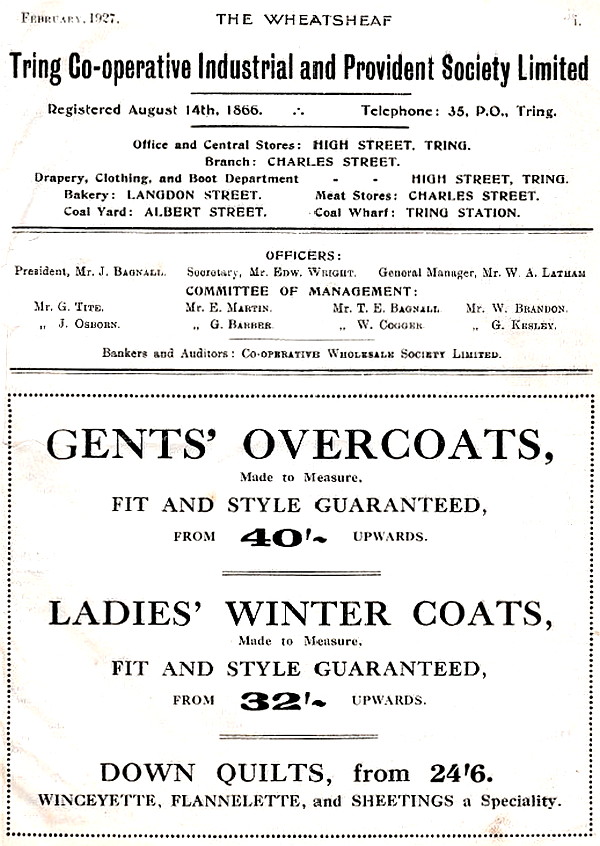
Whatever
happened to the Tring Co-operative Society?
Then you come to another pub, the Robin Hood and into Brook Street
where Bob Bly had a furniture shop. He sold a lot of lino and
carpets and things in that shop.
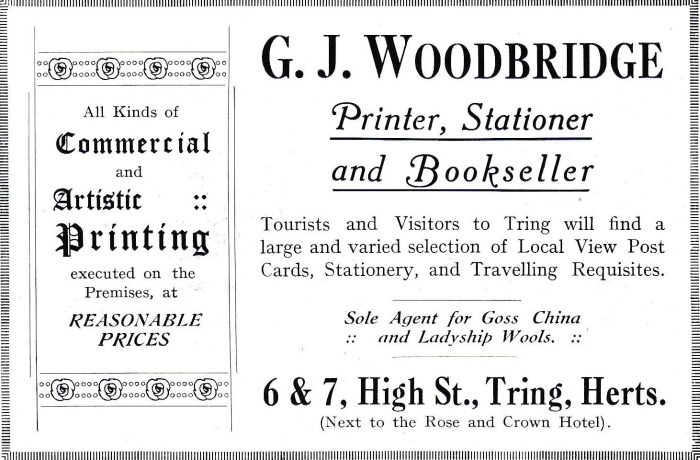
I have toured one side of the High Street and I am going up the
other side now. Past the Rose and Crown, next door to
Woodbridges which became de Fraines. They had stationery,
meccano and Hornby engines. The little side window always had
Hornby engines in. At the back they had a printing press where
The Bucks Herald used to be printed at one time, or some of
it. Next door to de Fraines was Westrons fruit shop. I was
always told that the Houchens had it before the Westrons. I
can remember the Houchens, but I cannot remember them in that shop.
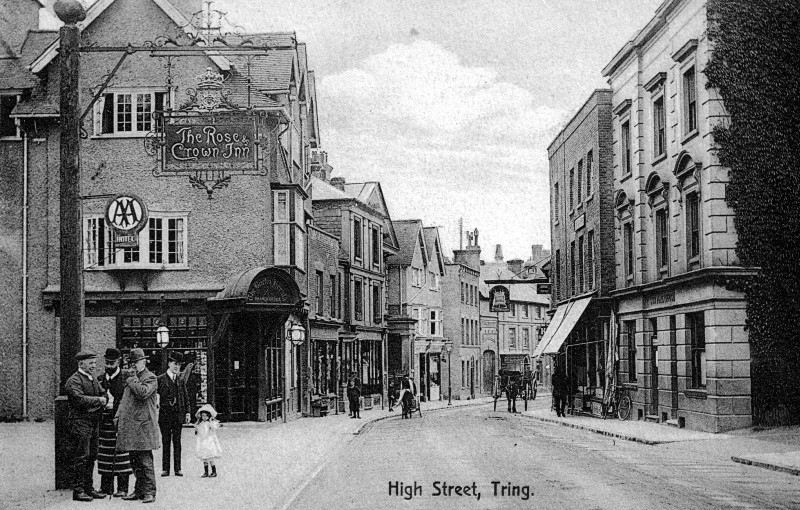
de Fraine’s,
corner shop on the left. Next to it Westrons fruit shop.
Then Glovers next door was a grocers shop. Then of course you
have the Provincial Bank which has always been there; the Midland
Bank hasn’t. When I was young there were two shops there.
I honestly can’t remember what those shops were. Next door to
the Midland Bank was the Surgery and then you had Salleries the meat
shop and Lawson’s the grocer who became Lovibond’s.
Continuing, Mrs Gates had a ladies hairdressers and then you had
Jefferies the Chemists which became Smiths. They Smiths came
when I was about four. Mrs Rodwell was the daughter of the
Smiths. The shop is still a Chemist.
Then you crossed the road (Akeman Street) and coming up the High
Street you had Meads the Butchers where Barclays Bank is now and
there was a dairy at the back. Then you had the Co-op
outfitters, Ladies, Gents, Shoes. Just before the Post Office,
that was the Co-op. Then you had a Post Office you could get
into without going up too many steps. You could post a letter
without having to go up any steps. You had a Postmaster who
was always polite and kind! We had a variety of postmasters,
Mr Tompkins, Mr Hurdle, I can’t remember anymore at the moment.
Next door to the Post Office was Bagnall’s Jewellers, where Brian
Planton is now. I am going to tell you where he was before he
came there later on. Next door to Bagnall’s was the Men’s
Hairdressers which became Child’s the Shoe Shop.
Then you had Brandon’s. If you should buy one of these little
books (A Glimpse into Days Gone By) you can see all the
things that Brandon’s would have sold. Probably some of us
have still got tables and chairs that were bought there. I
have actually. It was very good. They had another branch
in Chesham.
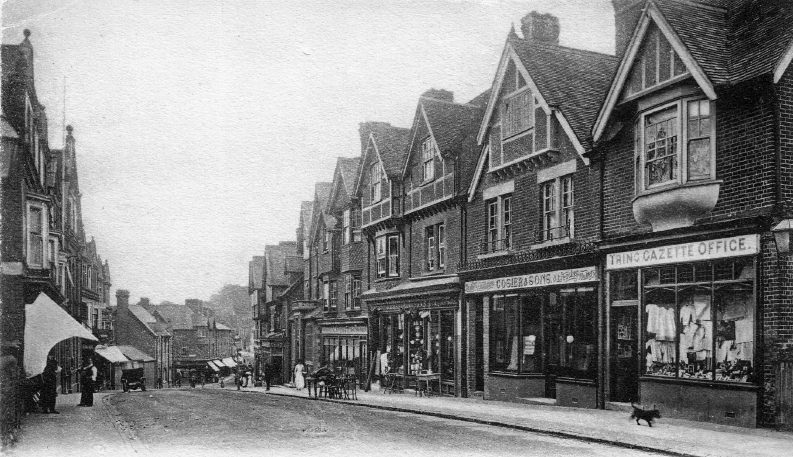
Third from
the right Brandons; then Cosier & Sons (tailors) and the Tring
Gazette Office.
Then you had Cosier the tailor. Next door to Cosier the tailor
was a shop that was always boarded up and had a heading called
Tring Gazette and there was a house attached which, we were
always told as children, was haunted. Haunted by what or who I
don’t know but we were told it was something to do with the
Rothschilds.
Next to this was Waldock’s the bakers and Allison’s the chandlers.
That became Reeve’s furnishing shop. Then you had Barclays
Bank up there. That was the High Street.
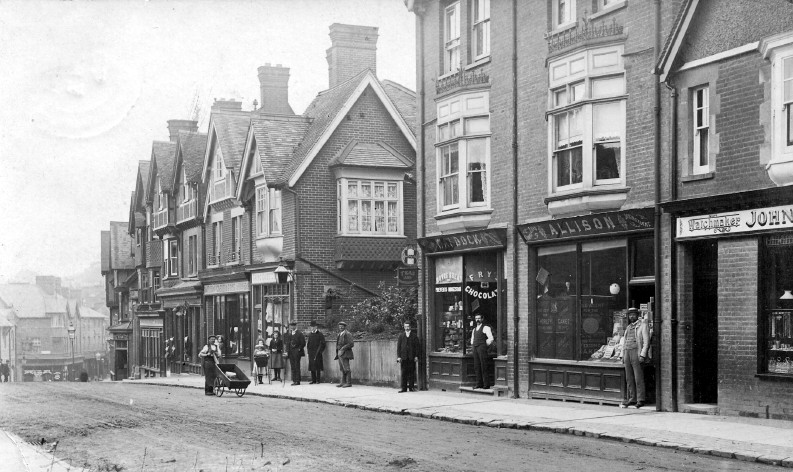
Waldock’s the bakers and Allison’s the chandlers.
I counted them before I started and there was one hundred and eleven
shops in Tring. I am going up the side streets now.
Mrs Castles shop was two doors away from the School. The
schoolboys found out that just inside the door was a mat with a
lovely bell. We learnt that if you put a foot on the left and
a foot on the right you could miss the mat altogether. You
could fetch something off the counter. Go like that on the mat
and go back to the counter again.
Some of you know Geoffrey Cowen. Well it was his Grandmother,
old Mrs Castle. I lived next door for seven years when I was
first married.
Now Akeman Street. Akeman Street was a very busy road.
It is a very busy road now with all the traffic, bangings and
shoutings that go on there. Now on the corner, the other side
to the Victoria Hall was Parke’s electrical shop. It became a
cafe for a time but did not last too long.
Now I am sorry I did leave out Tescos. Ahh, I left it out on
purpose. It was down here amongst Greening’s, Jones’ and
Batchelor’s shops. It was only a small one and it didn’t last
very long.
Then you had the Vic (Victoria Hall) which we are in now. Next
door was Sayer’s shop, they had a men’s hairdresser one side and
papers and stationery the other side and a little private Library.
Then you had The Manse for Akeman Street Chapel. During the
War it became a dairy and after a dairy Duncan Mead had it as an
Antiques Shop. Then next door to that was old man Sykes with
his sweets which became Tuck Shop.
Then there was a fish shop. Then if you go past where I live
(16 Akeman Street) and to the corner before you go up to Oaklawn,
there was Woodward with his wine shop/off licence. He used to
deliver his goods etc. up to Cholesbury on a Saturday night and I
gather, well I have always been told this, that the horse always
knew his way home. That became Victoria Wine before it went up
to the High Street.
Then there was Mrs Bull with her sweets and food shop on the other
side of the way into Oaklawn. Then you had Bond’s the bakers.
Then you go up Akeman Street to the bottom of Albert Street and
there was Batchelor’s shop, which literally sold everything.
Paraffin, sweets, food, grocery, toys. At Christmas time it
was an absolutely wonderful shop to go in. There were nice
sugar mice for a ha’penny.
Now further up from Batchelor’s was Dixon Sear, butchers. Mrs
Sear bred Sealyham dogs. I used to have an uncle who came from
Colchester every now and again to buy a Sealyham dog. Then you
have the Museum.
Coming back on the other side of the road you have Reg Batchelor on
the corner of Albert Street with his pet shop. He had
canaries, budgerigars etc. outside. Then, you know where
Honour’s Yard is, there you have the old Picture Palace, next door
to which you had Turney’s shop, where they sold everything.
You see no one had a car, you all had bikes. It was amazing
how many punctures you had if you were not careful.
Coming down a little further (towards the High Street) you had
Florry Howlett with her general stores which most of you will
remember as Peacock’s. Then next door were two little
cottages, then you had Warrior’s the bakers. Mrs Goodliffe’s
parents had Warrior’s the bakers.
You came almost opposite here (Victoria Hall) to Pricket’s the
printing shop. They had printing up the yard similar to the
one where Salleries used to be. Old Mrs Prickett and her
father. They had a little shop where they sold stationery and
they also had the Harrow Inn. I was with someone the other day
and they were talking about all the pubs in Tring (that’s another
walk around Tring) and they were talking about the Harrow Inn.
This person was sitting in her wheelchair and the other person said
to her “What sort of Harrow was it?” I looked and I knew what
was coming “The sort of bow and arrow type.” So I kindly told
the person that it wasn’t. It was the type you used when you
were farming.
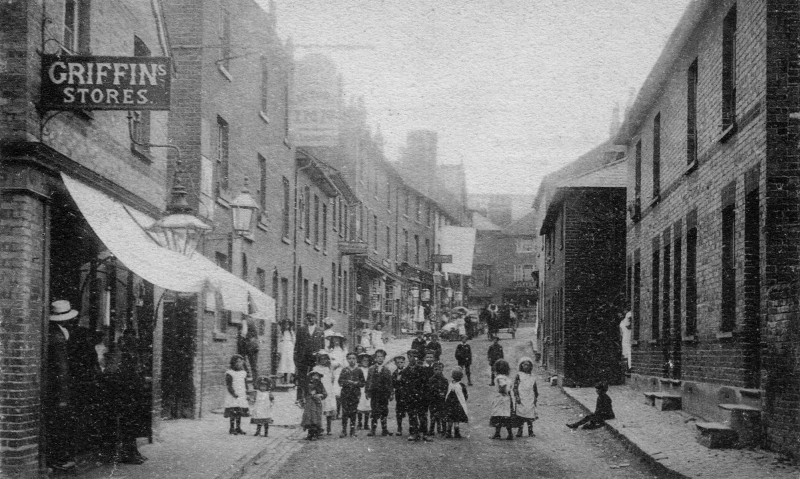
Looking up
Frogmore Street towards the crossroads.
Griffin’s the grocer is on the left.
Then you went into Frogmore Street. You had Stevens another
cycle shop, which became Fancourt’s. Next door you had
Tompkins who had a greengrocer and a few odd tins of things, which
became Vennings, which became Jefferies. Then there were two
sisters who had a wool shop, two Miss Kinghams. They had a
little wool shop. Then you had a little bit further you had
Griffins the grocers which became Goodliffe’s. You had Bobby
Bell opposite on the corner who sold fruit. Then he sold
second hand goods.
Further down, where the bakery shop is now, you had Putnam’s.
It then became Hawe’s and back on the other side you had Price’s
shoe shop and Johnson’s the fishmonger.
That is Akeman Street and Frogmore Street. However you have to
remember there were other shops in little side streets. Chapel
Street had Tommy Simmonds with his groceries on the right hand side,
the side of the surgery. In Henry Street, Keys had a
confectioners shop and Hawes the bakers.
In King Street, for those of you who don’t know much about Tring,
where Doctor Plum used to have her surgery, it used to be Howlett’s
general stores and Post Office and further up old Mrs Barker had an
off-licence. Coming out of Gravelly School, what did you do?
She had some lovely boards outside and every child who went to
Gravelly knew how to jump up and down on those boards, didn’t they?
There was a cellar underneath. They were lovely boards.
You only did it so she came out with her two teeth to have a go at
you.
In Charles Street, on the left hand side going down, you’ve just
gone past the Kings Arms, round the corner on the left hand side
Miss Broom had hats in her front window. Opposite, on the
other side, Mrs Ives had the remnants from the shop in the High
Street to sell. However, she was very good at selling cottons
and needles. Times you got a farthing of pins instead of a
farthings change was nobody’s business. Then you had, rudely
speaking, we used to call “Jampot Howlett” in King Street and “Oily”
Howlett in Charles Street, who was the ironmongers. You could
buy candles, anything there. Back down on the corner was the
Co-op Grocery, the Co-op butcher and the Co-op baker. They had
a bake-house in Langdon Street which supplied the Co-op with bread.
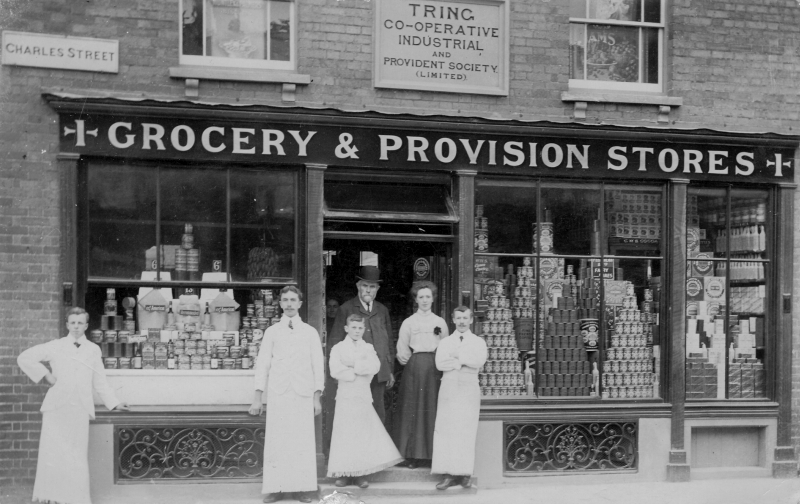
Tring
Co-operative Industrial & Provident Society (Ltd), Charles Street.
In Albert Street, you had old Mr Simmonds with his horse and cart.
He sold fruit and veg and he always had a stall on Saturday evenings
in the High Street. There used to be Howlett’s the bakers and
Mr Simmonds used to have a stall where the Market used to be in the
street on a Saturday evening.
On the left hand side going down you had Tarmer and Eldridge,
shoe-menders and shoe shop, and Bagnall’s the tailor next door.
On the other side of the road was Kirby’s, which became Colby’s,
general stores and old Miss Greening sold sweets in one of those
tall houses next door to the Salvation Army Citadel. She sold
sweets from one of the cellar rooms. They were nice jars of
sweets.
That is all actually in Tring itself. But, if you went into
Brook Street you had Brook’s half way down where you have that Post
Office cum general stores now (New Mill Stores) and Pat Gower’s
father, Ben Gower, had the general stores and Post Office in New
Mill where the hairdressers is now. I asked Pat before I
started talking as to whether she was born there. She wasn’t,
she was born in Western Road. Her father was born in New Mill.
Also in New Mill you had Hunt’s round into Bulbourne Road which
became Ayres’ and the butcher’s shop which is now Gregory’s used to
be Baldwin’s.
I didn’t do cafe’s, but there was the Temperance Cafe at the bottom
of Tabernacle Yard (Akeman Street), where Marian’s is now.
Businesses advertising in 1930 in the
Tring Parish Church Magazine.
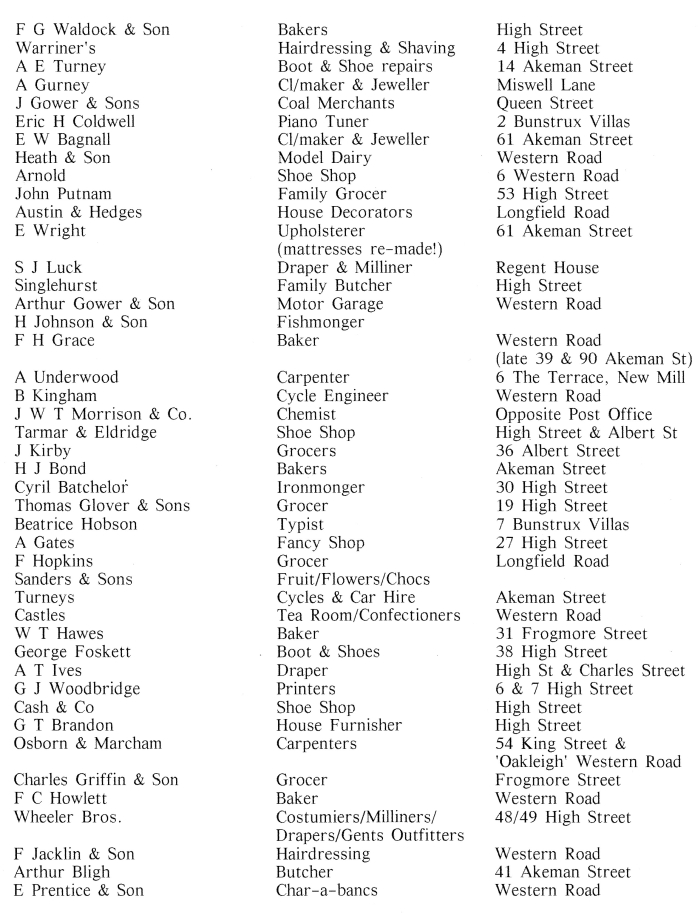
End of talk. |